Belt Conveyors
Introduction
This article will take an in-depth look at belt conveyors.
The article will bring more understanding on topics such as:
- Belt Conveyors and their Components
- Types of Belt Conveyors
- Design and Selection of Belt Conveyors
- Applications and Benefits of Belt Conveyors
- And Much More…
Chapter 1: Belt Conveyors and their Components
This chapter will discuss what a belt conveyor is and its components.
What is a Belt Conveyor?
A belt conveyor is a system designed to transport or move physical items like materials, goods, and even people from one point to another. Unlike other conveying means that employ chains, spirals, hydraulics, etc., belt conveyors will move the items using a belt. It involves a loop of a flexible material stretched between rollers that are actuated by an electrical motor.
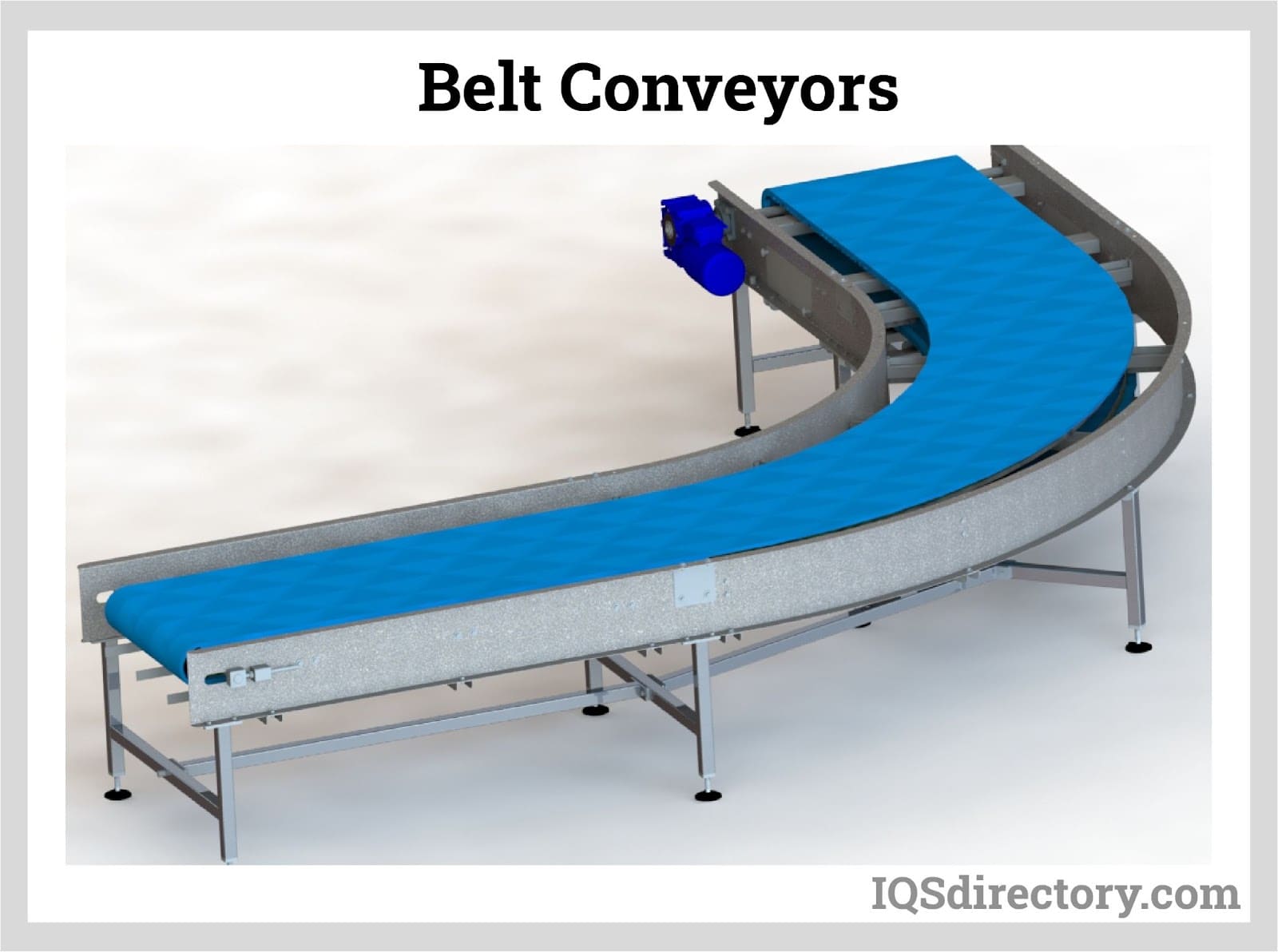
Because the items being transported vary in nature, the belt material also varies by the system it is employed in. It commonly comes as a polymer or a rubber belt.
Components of a Belt Conveyor
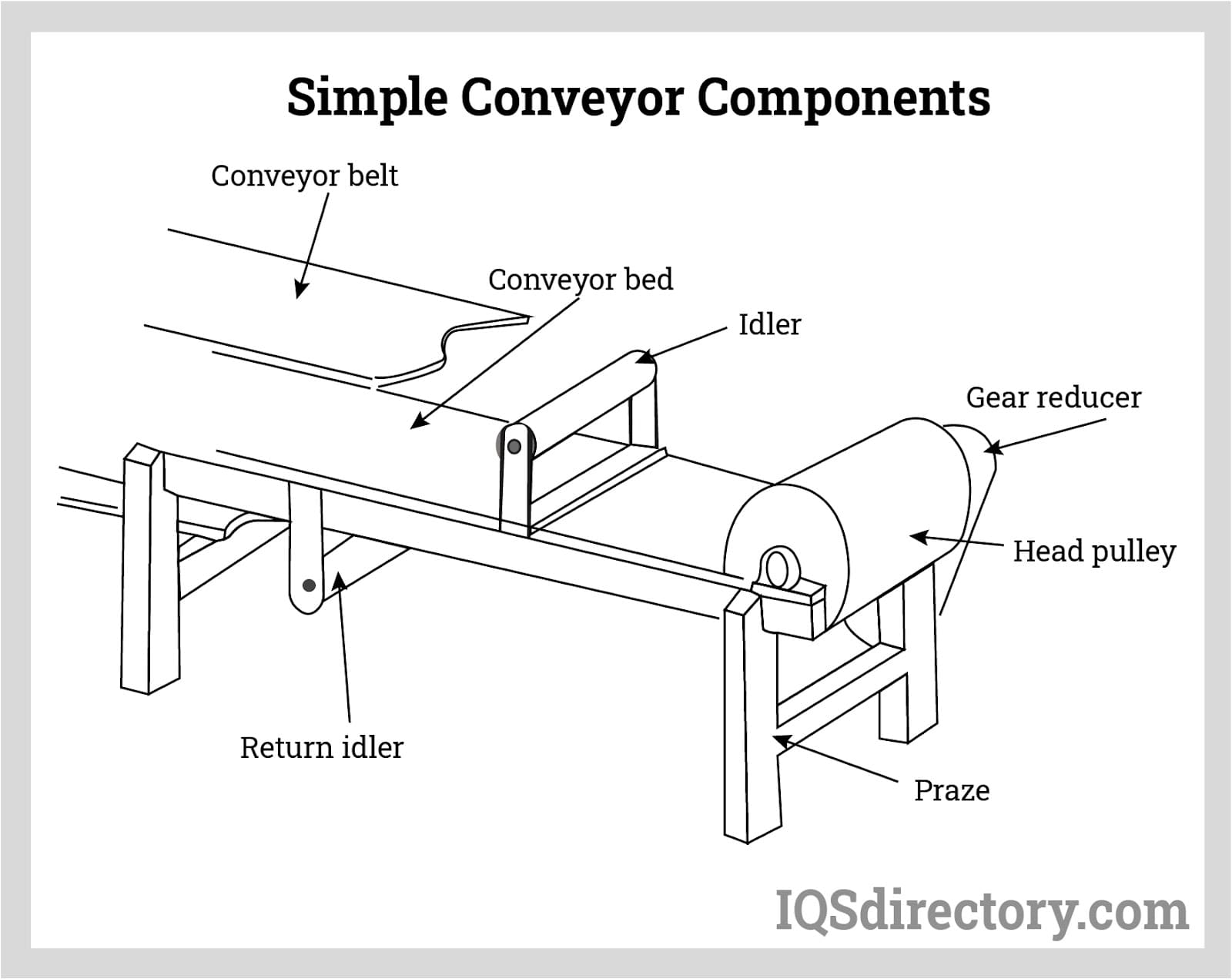
A standard belt conveyor system has a head pulley, tail pulley, idler rollers, belt, and frame.
Head Pulley
The head pulley is the one coupled with the actuator and the electric motor. The head pulley drives the conveyor, usually acting as the pulling force rather than pushing. It is mostly located at the point that the conveyor offloads its load, known as the discharging end of the belt conveyor. Because the head pulley drives the whole system, it is often necessary to increase its traction with the belt, thus it will have a rough jacket covering its outer surface. This jacket is termed legging. Below is what any pulley with a jacket would look like.
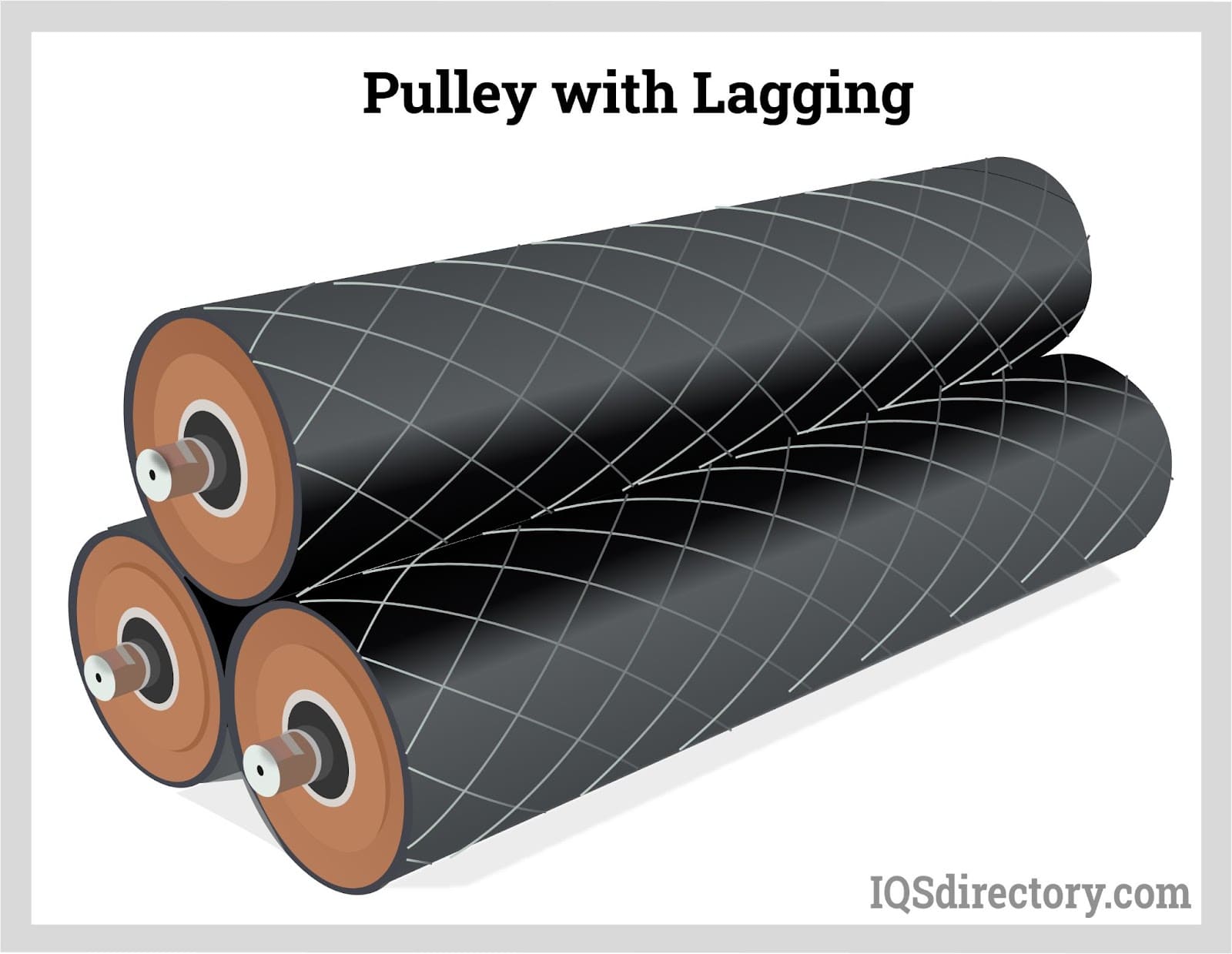
The head pulley usually has the largest diameter of all the pulleys. Sometimes a system can have multiple pulleys that act as drive pulleys. The pulley at the discharge end is a drive conveyor idler usually with the biggest diameter and will be identified as the head pulley.
Return or Tail Pulley
This is located at the loading end of the belt conveyor. Sometimes it comes with a wing shape to clean the belt by letting material fall aside to the support members.
In a simple belt conveyor setup, the tail pulley will be mounted on guides usually slotted to allow the belt’s tension. In other belt conveying systems as we shall see, tensioning of the belt is left to another roller called the take-up roller.
Idler Roller
These are rollers employed along the length of the belt to support the belt and load, prevent sagging, align the belt, and clean up the carryback (material left sticking on to the belt). Idler rollers can either do all of the above or any one of them, but in any space, they will always act as support for the belt.
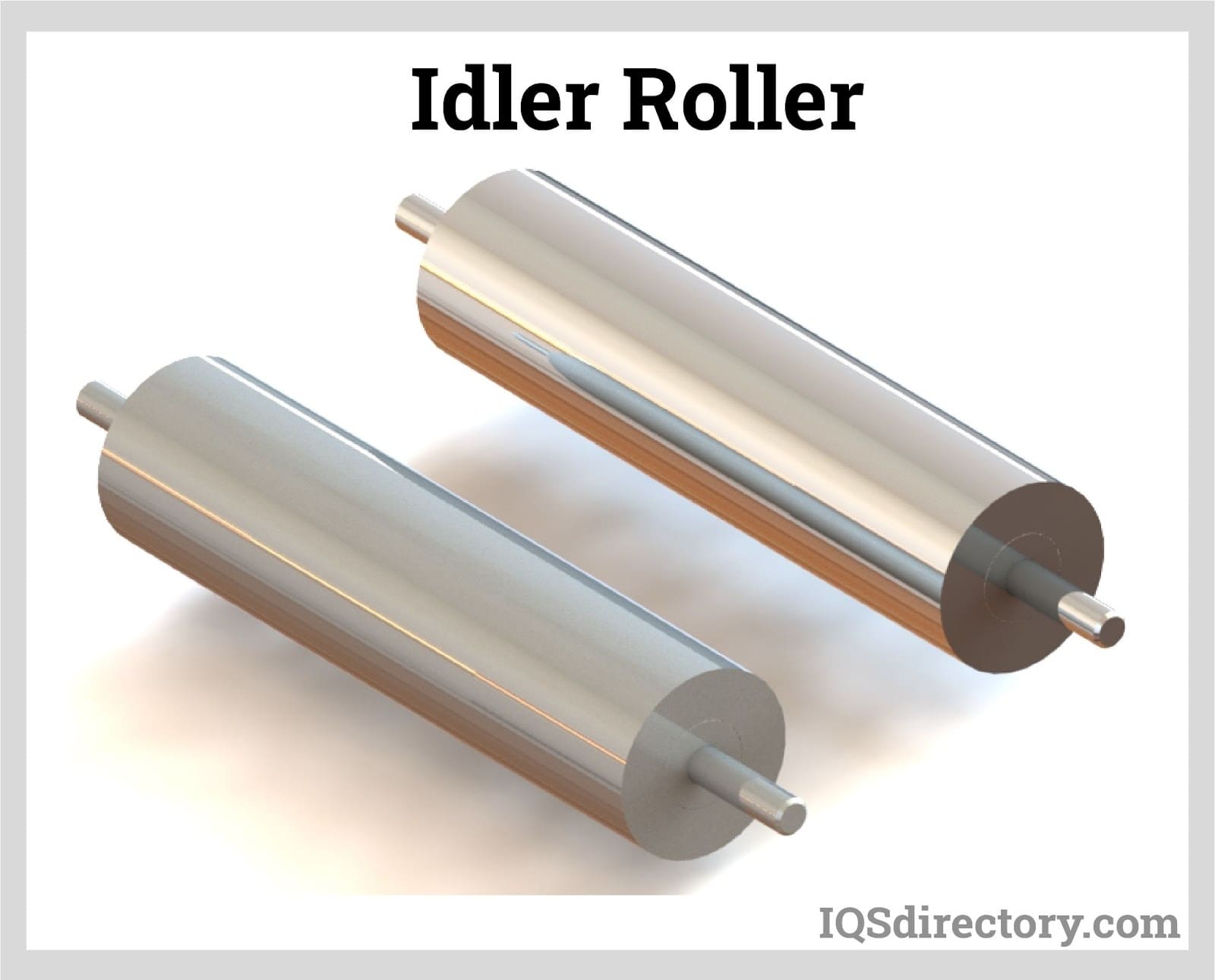
There are many different idler rollers for different functions, as listed below:
Troughing Idlers
Troughing idlers will have three idler rollers set up in a configuration that makes a “trough” of the belt. They are located on the side that carries the load on the belt conveyor. The idler in the center is fixed, with the two on the ends able to be adjusted. This is so the angle and depth of the trough can be varied.
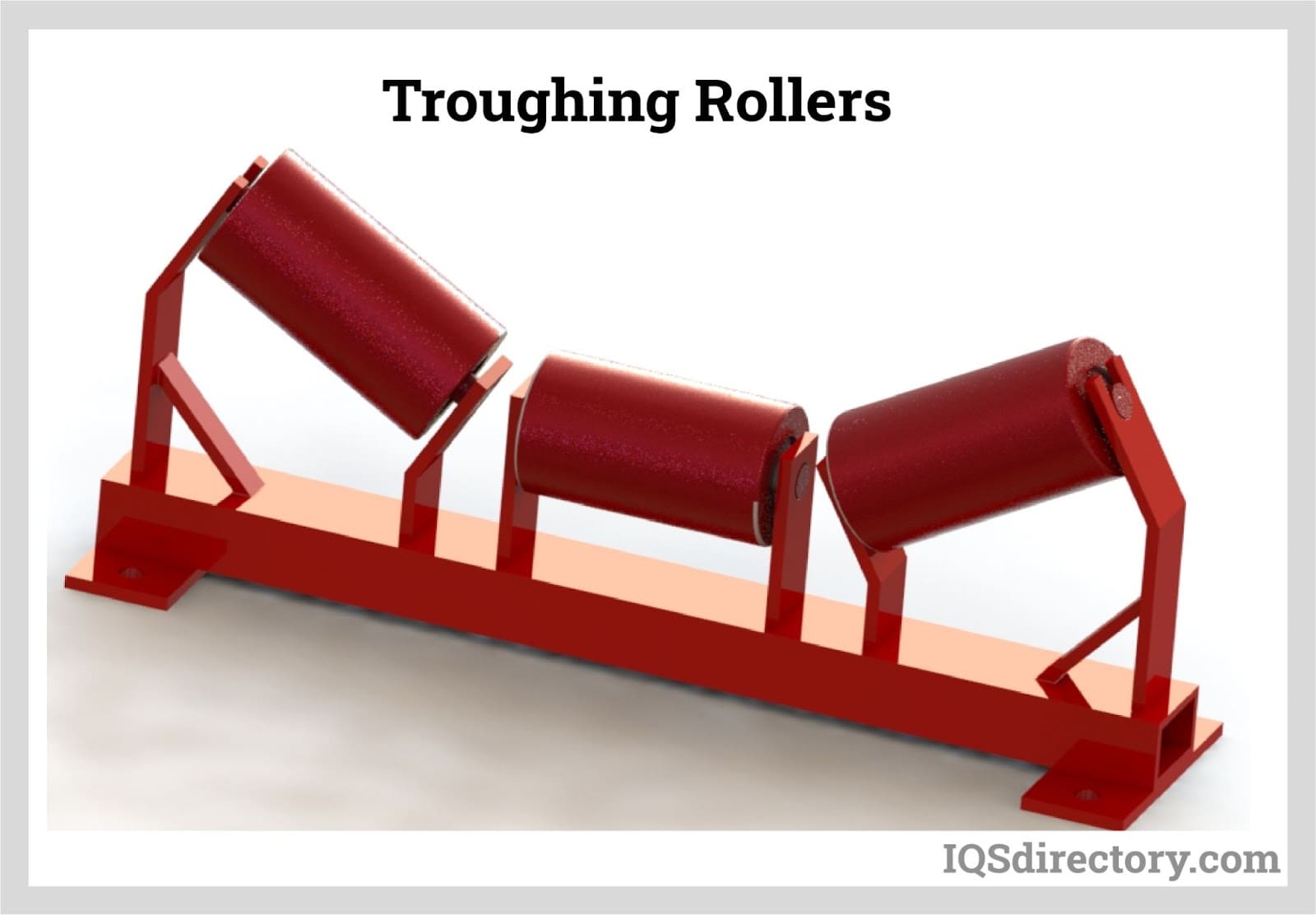
These idlers, when employed, will reduce spillages and maintain a constant cross-sectional area along the length of the belt conveyor. Maintaining a constant cross-sectional area is important for stability.
Rubber Disk Idler
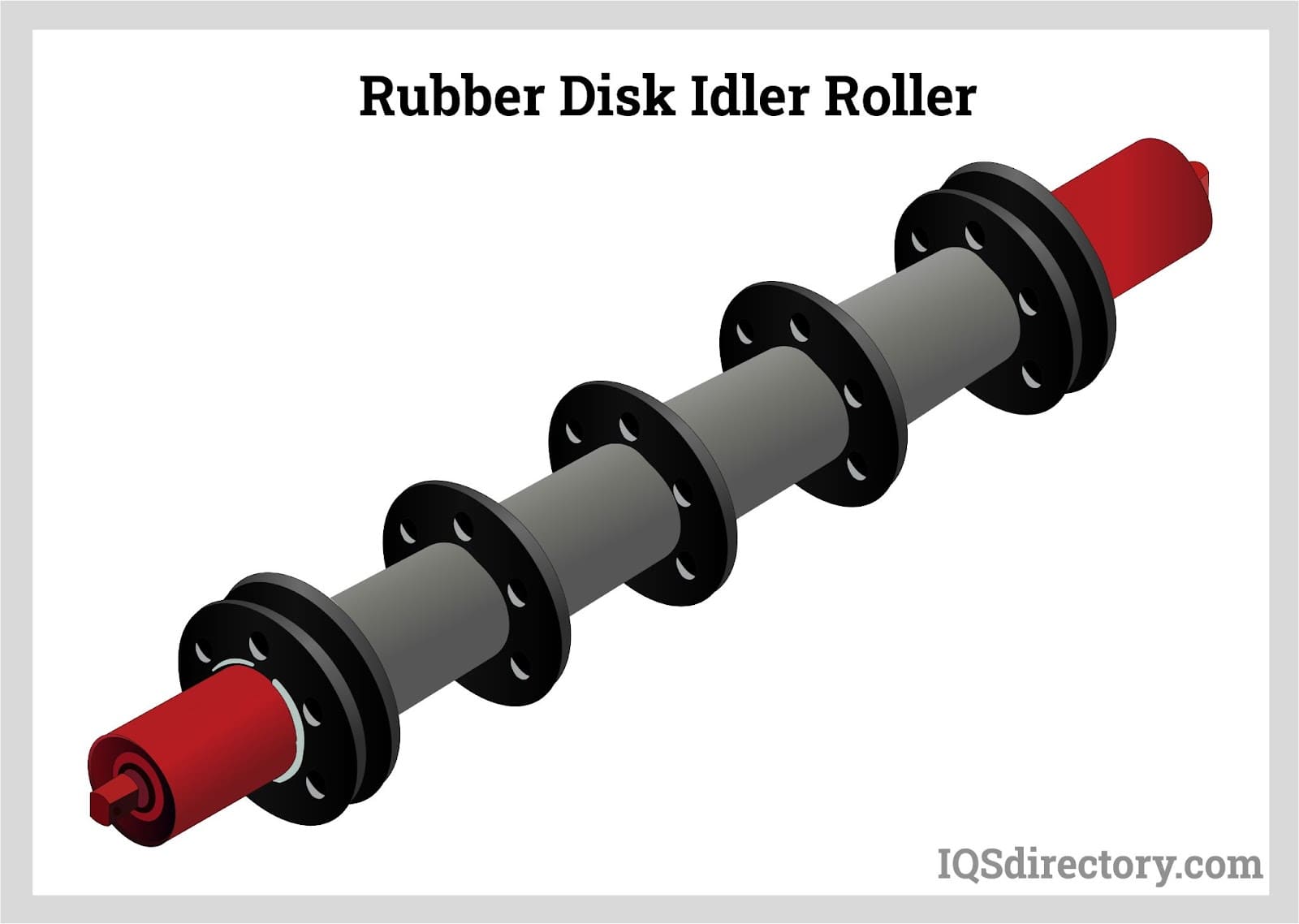
This idler has rubber disks placed at set distances along the axis of the roller. On the extreme ends, the rollers are much closer so that they can support the belt edge, which is prone to tear. The spaced-out disks will break off any connected carryback/ leftover material and reduce material building up on the bottom of the belt. This is a common cause for mistracking (when the belt shifts to one side of the system and causes misalignment).
Sometimes the disks are helical like a screw and the idler will be called a rubber screw idler roller. The function will remain the same. An example of a screw idler roller is depicted below.
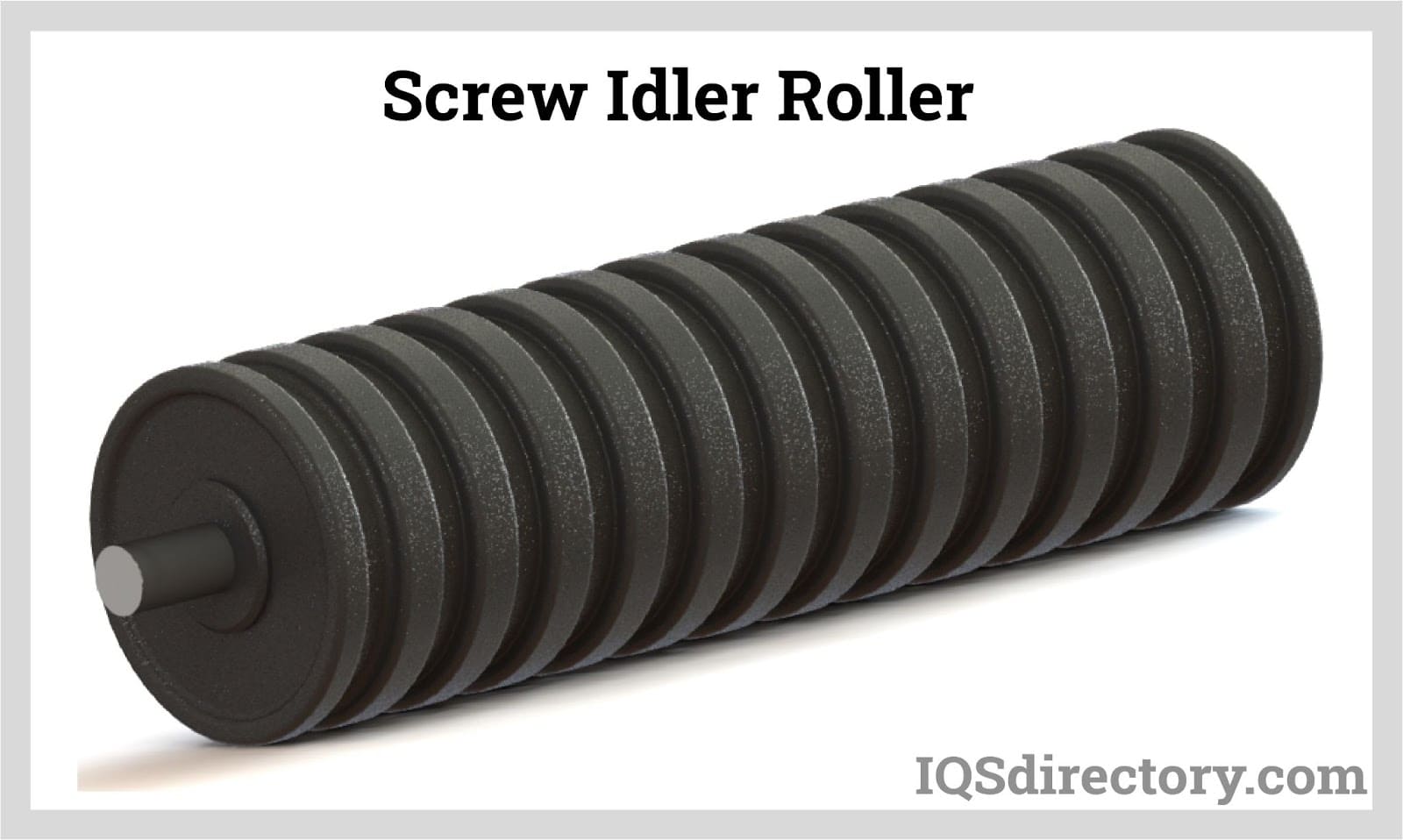
The screw idler can also be made out of rubber helix. Screw idlers are most common where a scrapper that takes off carryback would not be feasible, especially on mobile belt conveyors.
Trainer Idler
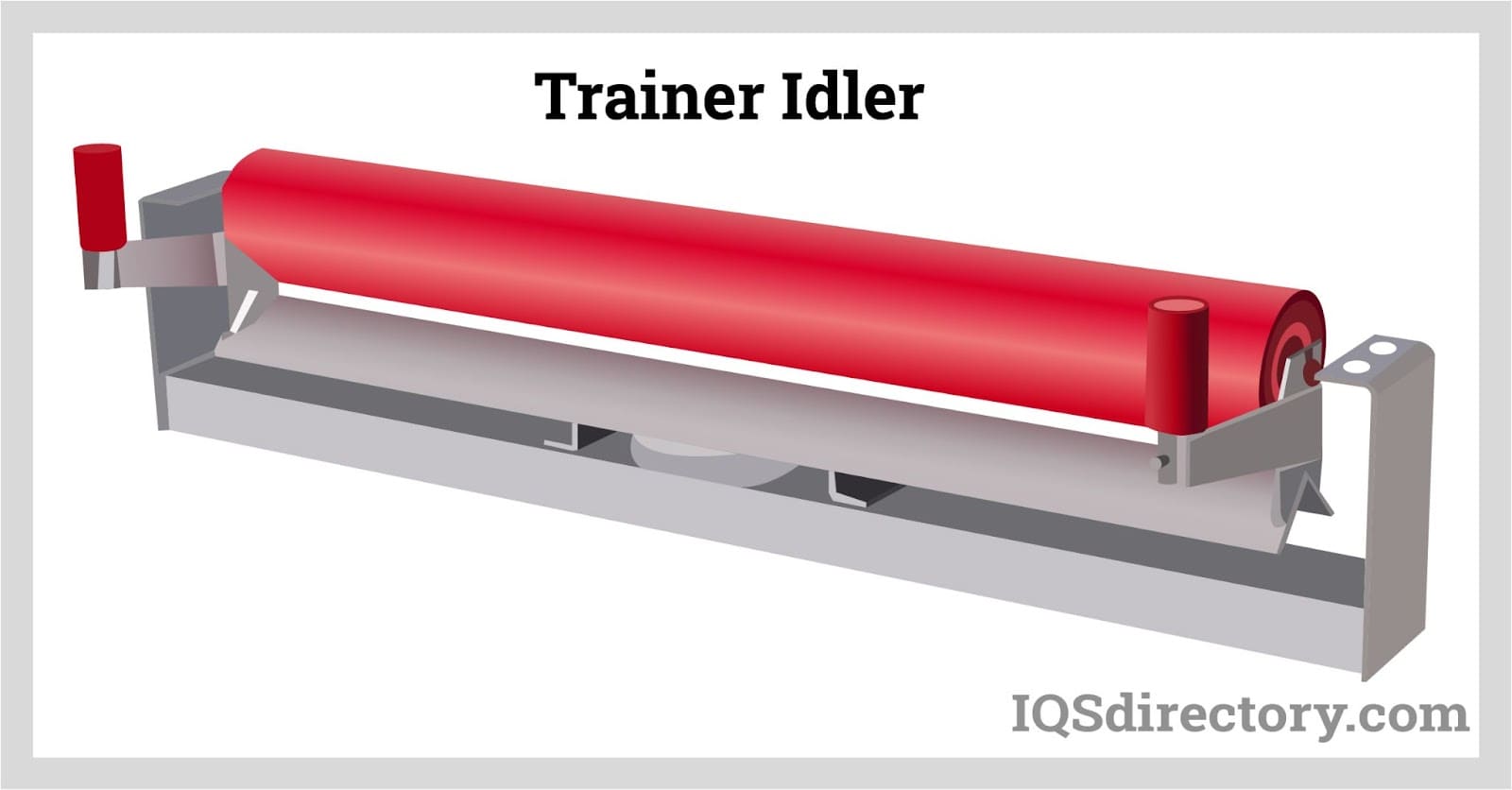
Trainer idlers keep the belt running straight. It works against mistracking. It achieves this by a central pivot that swerves the roller back to the center should the belt drift off to one side. It also incorporates two guide rollers to act as guides for the belt.
Conveyor Belt
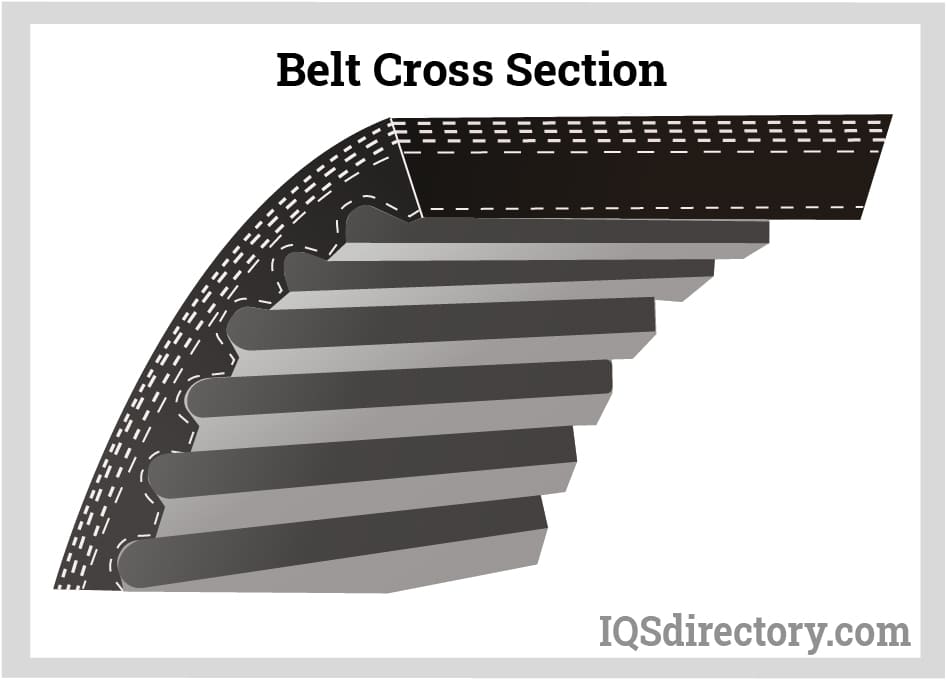
In setting up a belt conveyor, the belt is perhaps the most intricate. The tension and strength are important since the belt takes a lot of punishment when loading and ferrying the material.
The growing demand for longer conveying lengths has catalyzed the research into new materials, though this always comes at a cost. Stronger belts that adhere strictly to environmentally friendly rules tend to come with high setup costs, sometimes the costs can hardly even be justifiable. On the other hand, if an economical approach is taken, the belt usually fails, resulting in high operating costs. Costs for the belt should usually range below 50% of the total cost for the belt conveyor.
A belt is made up of components such as:
Conveyor Carcass
Since this is the skeleton of the belt, it has to provide the tensile strength needed to move the belt and the lateral stiffness for supporting the load. It must also be capable of absorbing loading impact. The belt is a loop so it has to be joined; this is known as splicing. Because some of the splicing methods require the use of bolts and fasteners, the carcass must be able to provide an adequate and firm base for these fasteners.
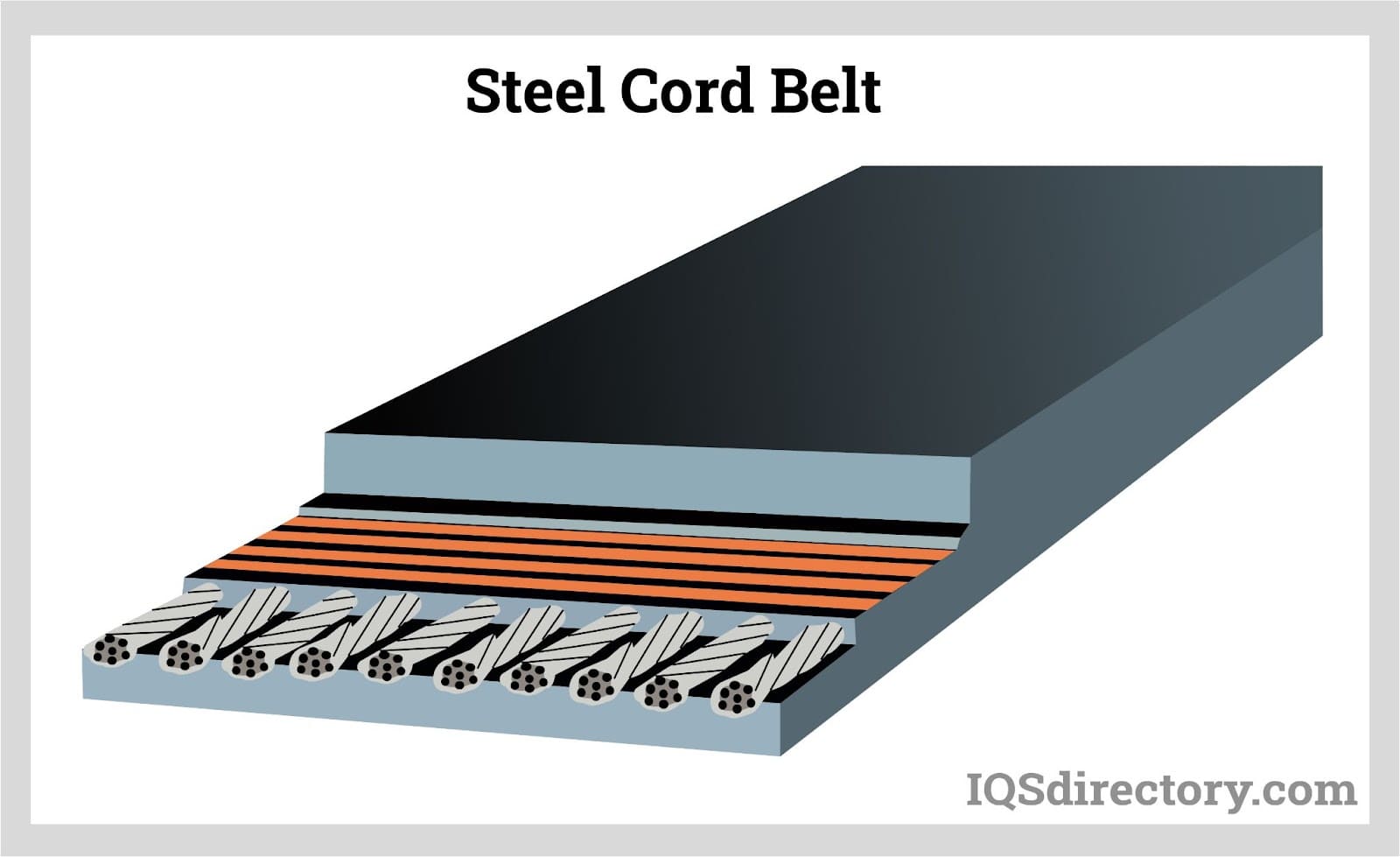
The carcass is commonly made of steel cord or textile ply. Textile ply is made from fibers like aramid, polyamide, and polyester. If only one ply is used, a PVC-coated textile carcass is also common. Carcasses can have even six layers piled on each other. The carcass can also include the edge protection that is very much needed in bulk conveyor belts.
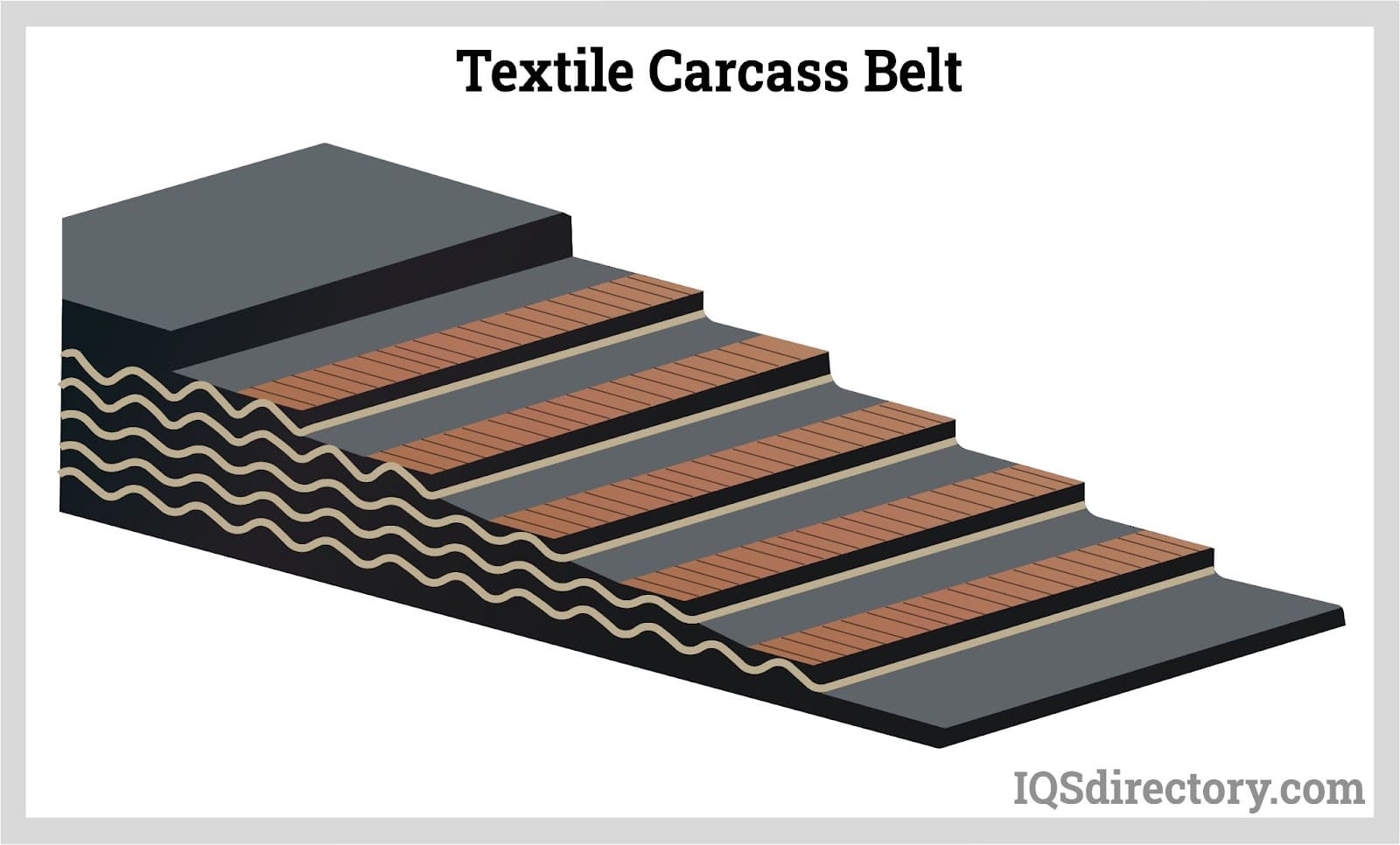
Conveyor Covers (Top and Bottom & Sides)
This is a flexible material made of rubber or PVC. The covers get exposed directly to the weather elements and the working environment. Careful consideration of the covers must be made depending on the intended use. The following usually require attention, flame resistance, low-temperature resistance, grease and oil resistance, anti-static, and food grade.
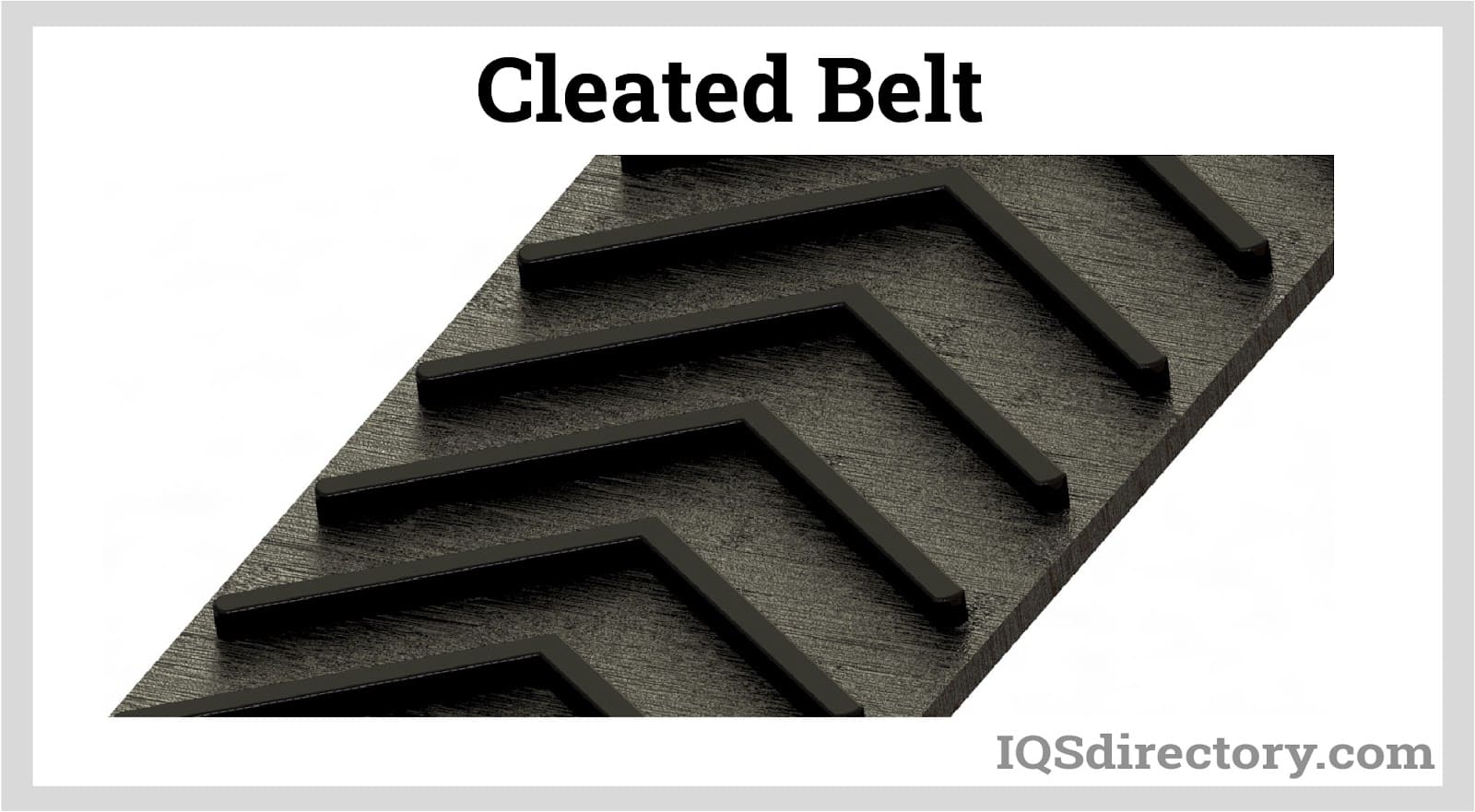
The carrying side of the conveyor depending on the load, the angle of inclination of the conveyor, and the general use of the belt all have special features. It can be corrugated, smooth, or cleated.
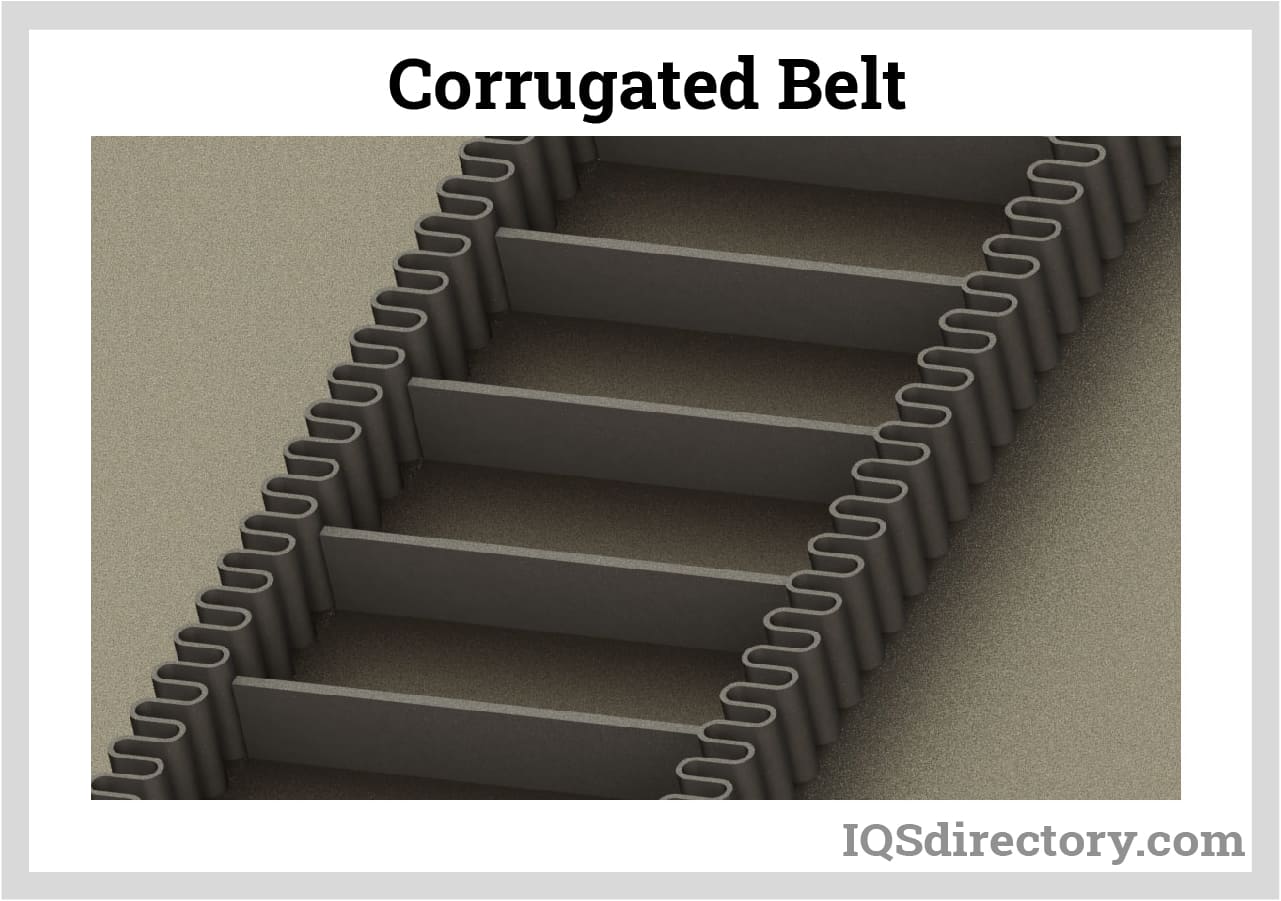
Other applications like scrap conveyors in CNC machines will employ a steel belt conveyor since this won’t wear as much as other conventional materials would do.
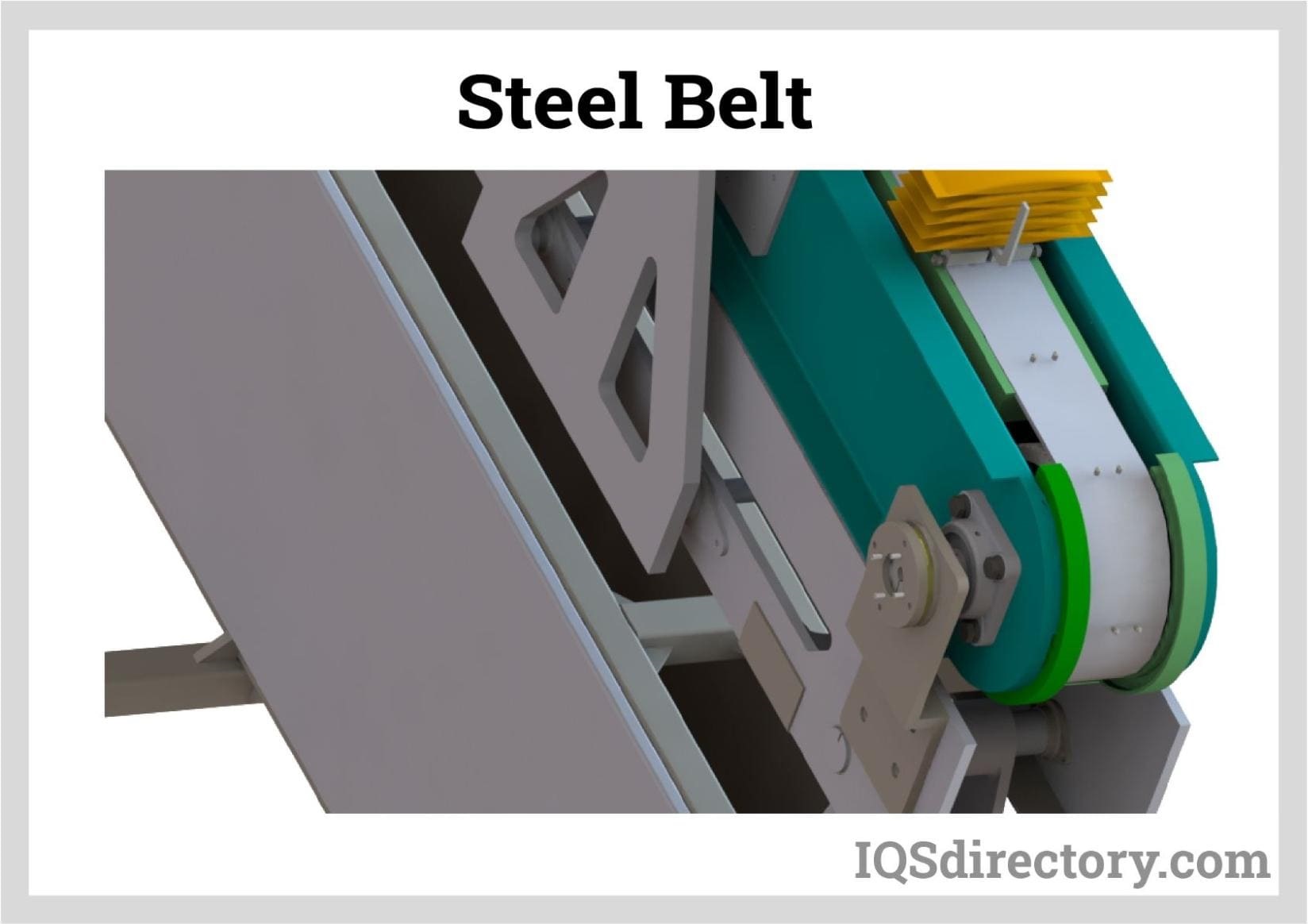
In food processing industries, PVC, PU, and PE belts are also used for the preservation of food and to minimize contamination.
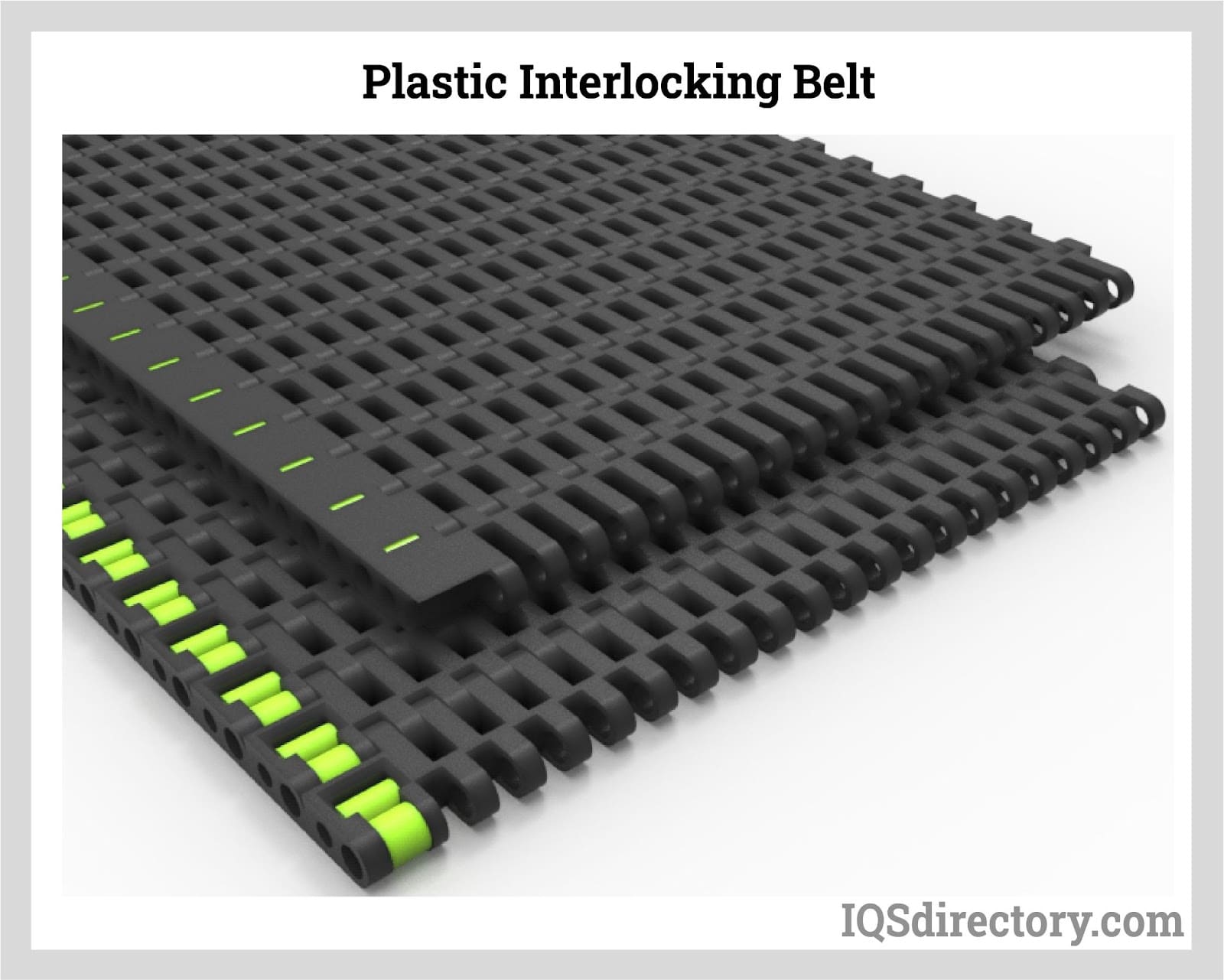
Plastic belts are fairly new, though due to their vast advantages, they are slowly gaining momentum. They are easy to clean, have a wide temperature range, and have good anti-viscosity properties. They are also resistant to acids, resistant to alkaline substances, and saltwater.
Conveyor Frame
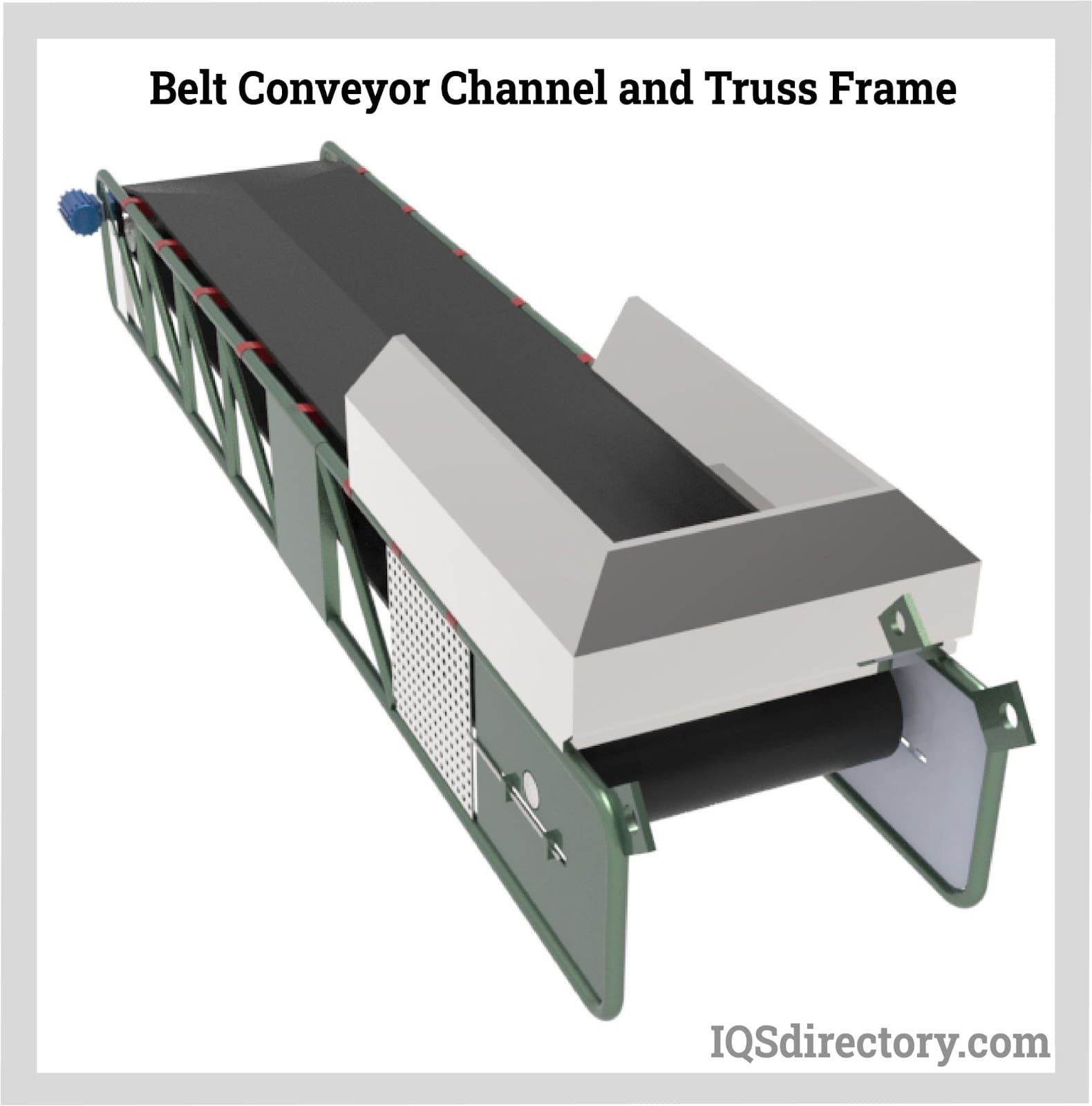
The frame, depending on the loading, height of operation, and distance to be covered will vary. They can come in a simple setup that can be represented by a cantilever. They can also be trusses in the case of larger loads. Extrusions of Aluminum are also employed for simple and lightweight operations.
The frame design is a critical aspect of conveyor design. A badly designed frame can cause:
- Belt running out of track
- Structural failure results in:
- Long downtimes translate to delays in production
- Injuries and casualties
- Costly Spillages
- Expensive fabrication methods and installation.
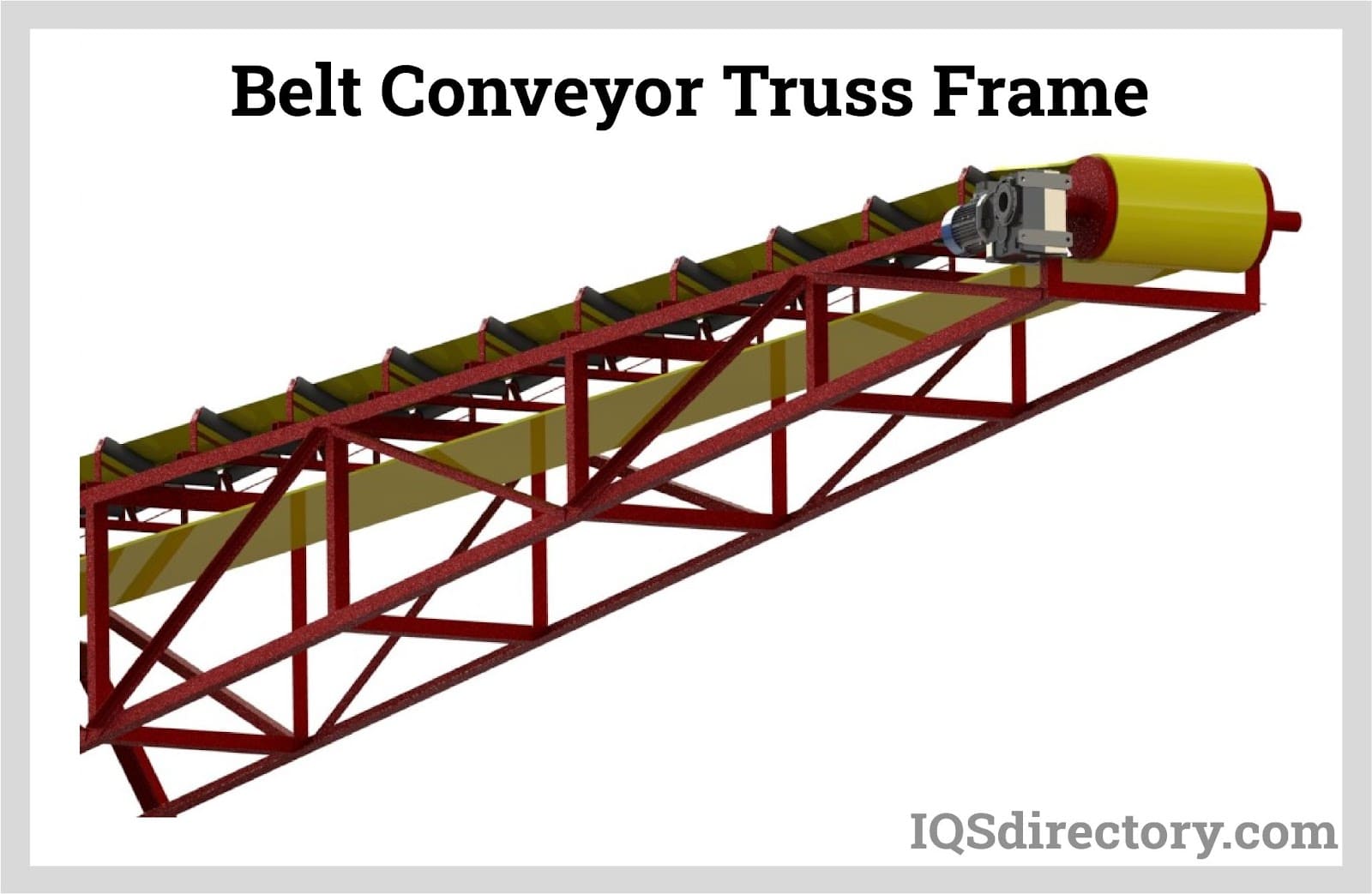
On the frame, other accessories can also be mounted like walkways and lighting as depicted above. Lighting situations will require sheds and guards to protect the material.
Loading and discharge chutes can also be mounted. Knowledge of all these possible add-ins is important to avoid uncalculated overloading.
Chapter 2: Types of Belt Conveyors
This chapter will discuss the types of belt conveyors. These include:
Roller Bed Belt Conveyor
The surface just under the belt on this version of a conveyor belt is made of a series of rollers. The rollers are closely stacked so that there is hardly any sagging of the belt.
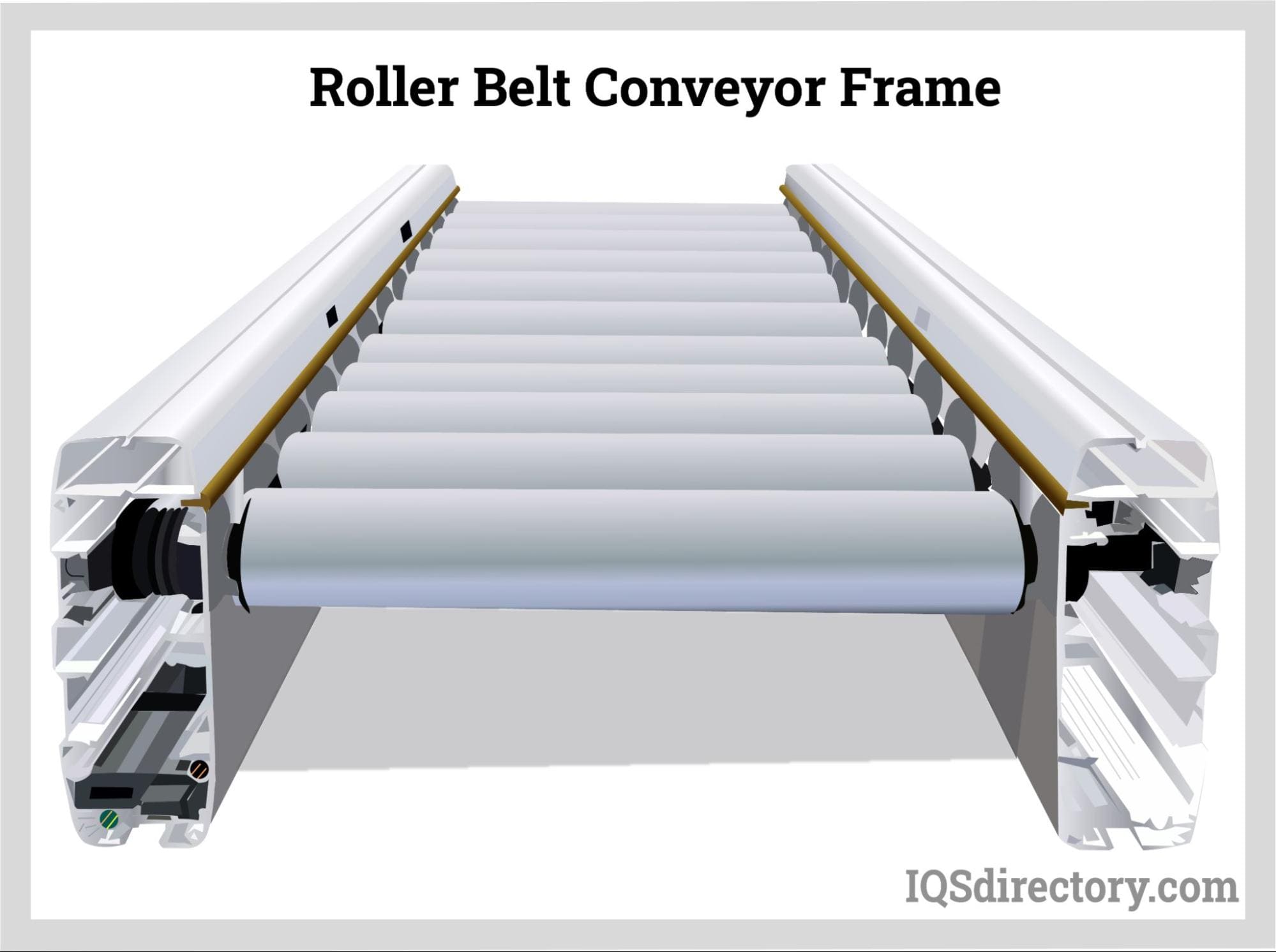
They are suitable for both long and short-distance conveying. In some instances, they can be so short that they only employ two rollers for the entire system.
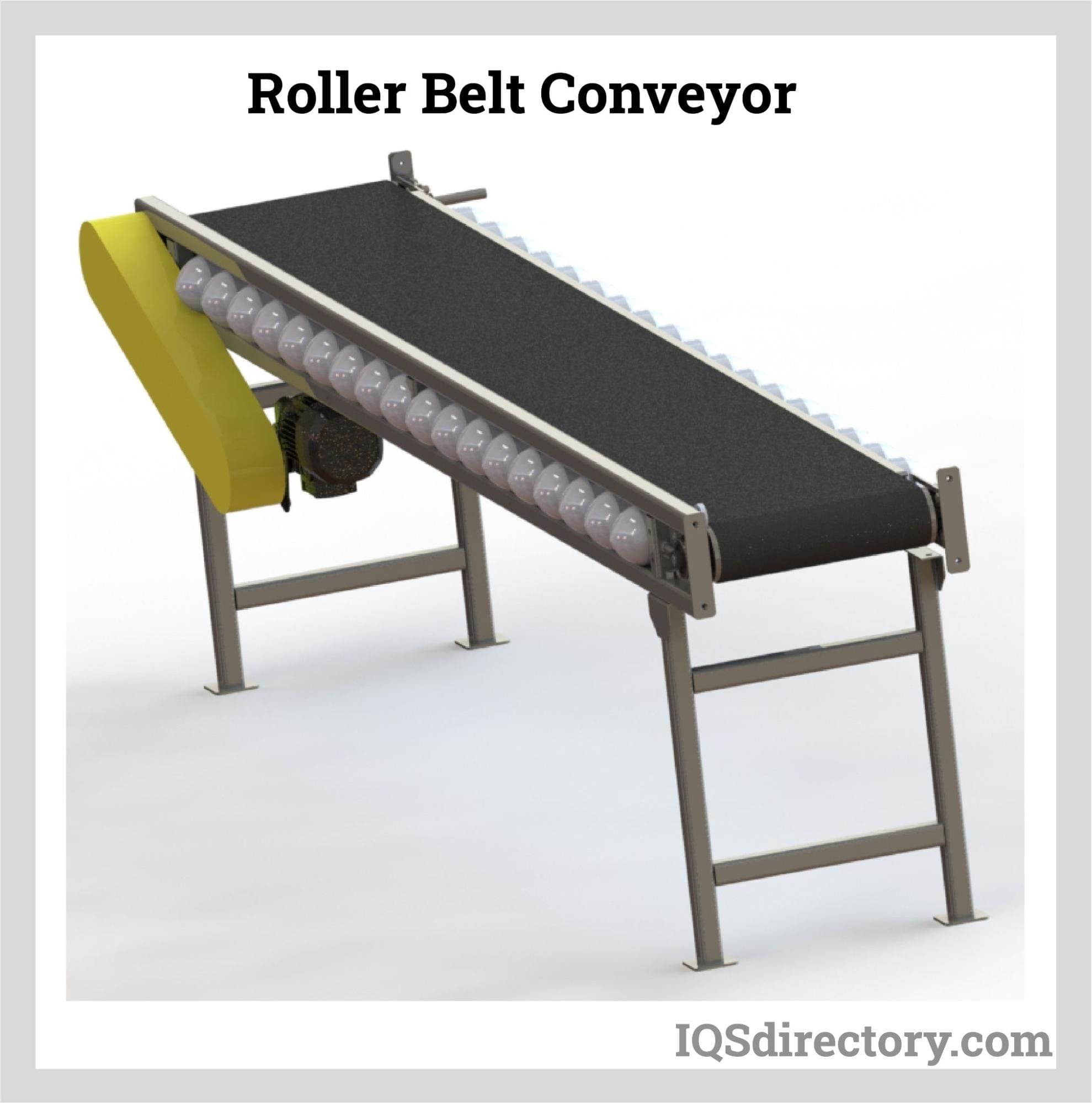
When using gravity to load, the roller belt conveyor is one of the best options to pick. If one used manual loading, the shock would damage the rollers easily since they usually have internal bearings. These bearings plus the generally smooth surface of the rollers greatly reduce friction which makes it easy for conveying.
Roller bed belt conveyors are used mainly where there is hand sorting, assembling, transporting, and inspection. Examples include:
- Airport baggage handling
- Courier items sorting including postal offices
Flat Belt Conveyor
The flat belt conveyor is one of the most common conveyor types. It is typically used to transport items within a facility. Internal conveyance requires a series of powered rollers/ pulleys to pull the belt.
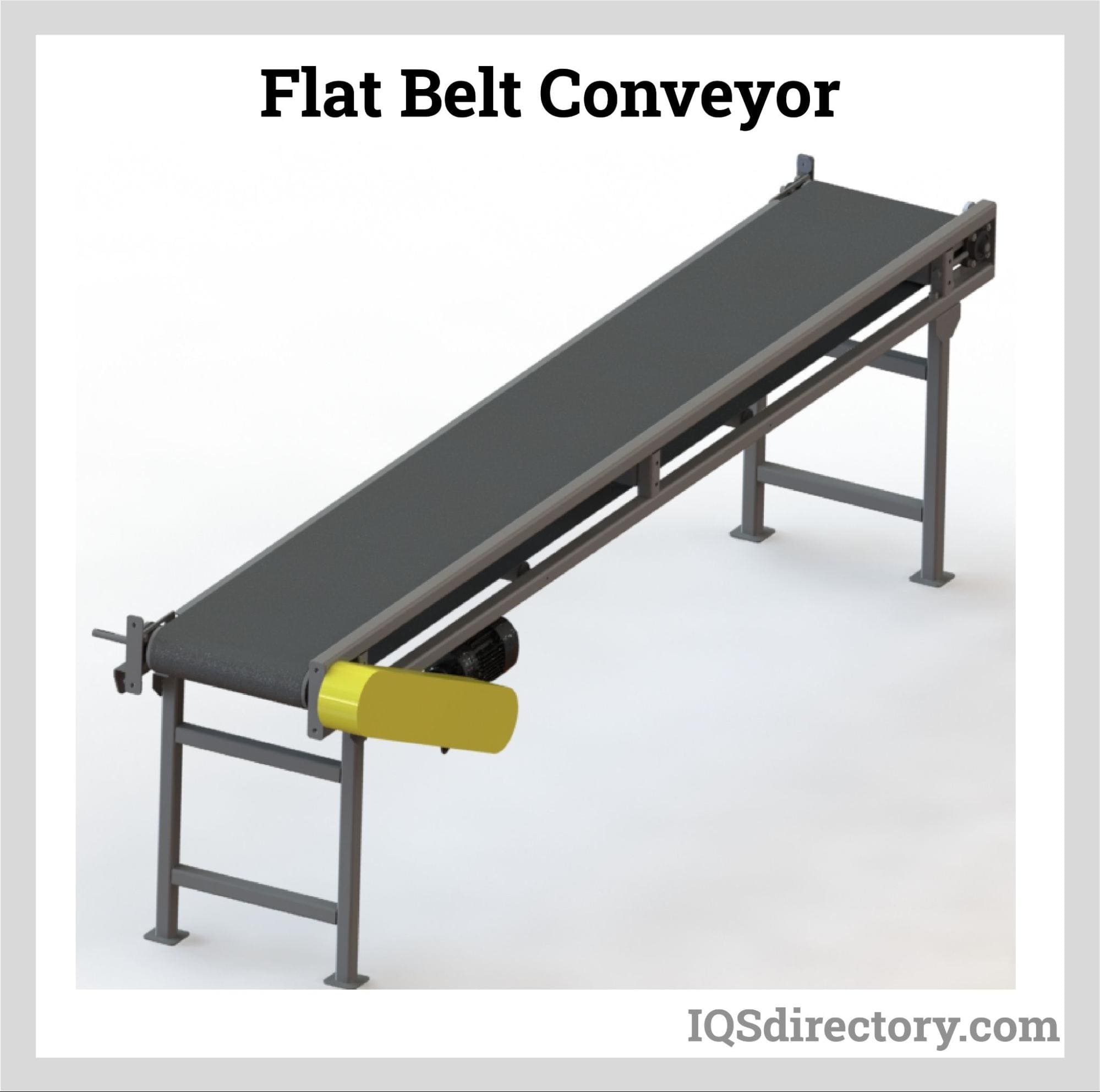
The belts employed for the flat belt conveyor vary from fabrics, and polymers to natural rubbers. Because of this, it becomes versatile in terms of materials to be transported. It is also very easy to align with the tail pulley usually mounted so it can be adjusted to align the belt. It is generally a low-speed conveyor belt.
The flat belt conveyor applications include:
- Slow assembly lines
- Washdown applications
- Light dusty industrial assembly
Modular Belt Conveyor
In contrast to flat belt conveyors that use a “seamless” loop of a flexible belt, Modular Belt conveyors use a series of interlocking rigid pieces commonly made from plastic or metal. They function more like a chain does on a bicycle.
This gives them a huge advantage over their flexible belt counterparts. It makes them rugged because they can work over a wide range of temperatures and PH levels.
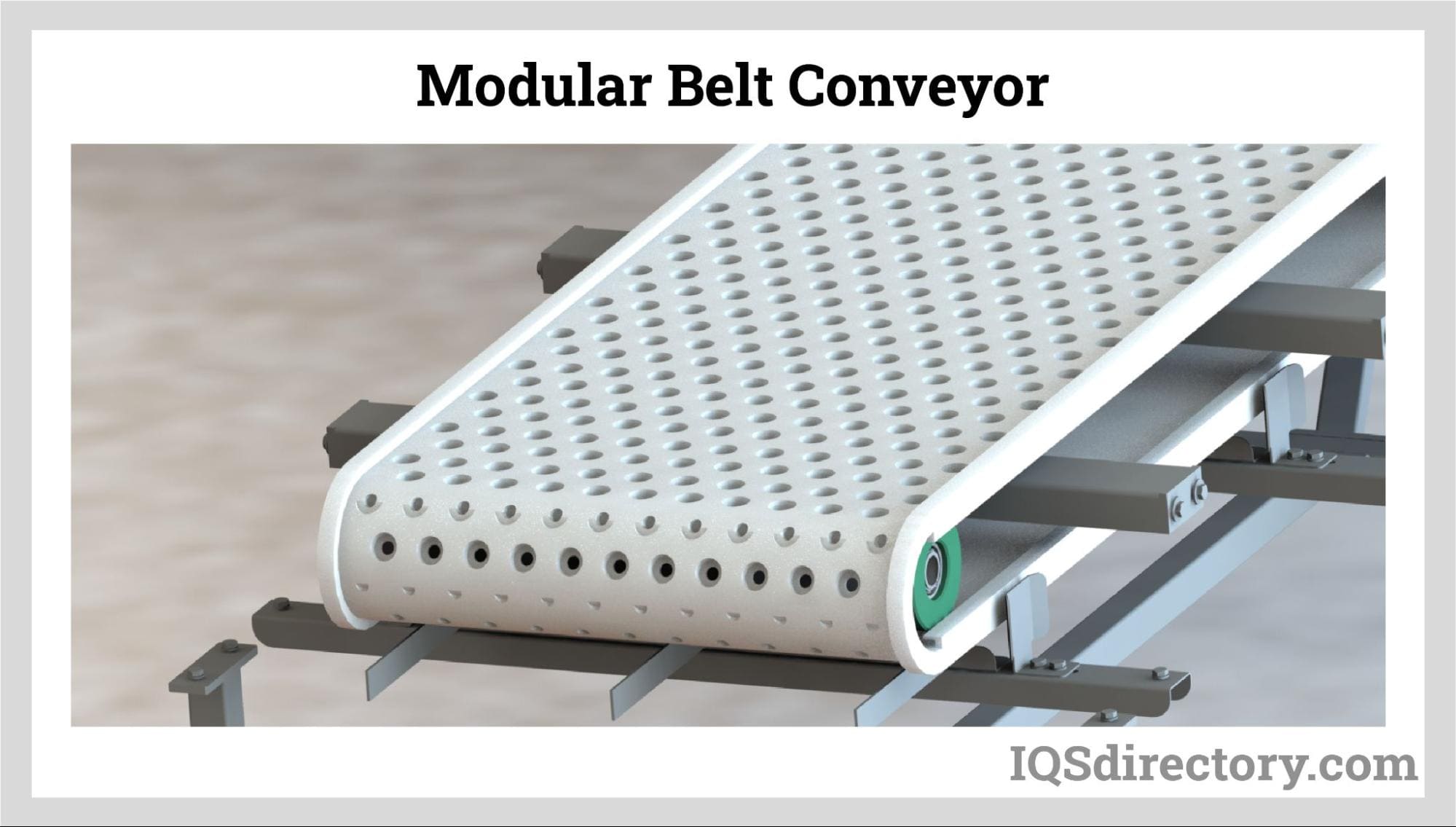
When a section of the belt becomes damaged, one can easily replace that particular section alone rather than the flexible belts where the entire belt would have to be replaced. Modular belts can travel, using only one motor, around corners, straight lines, inclines, and declines. As much as other conveyors can do the same, it comes at the cost of complexity and funds. For applications that may require an “unorthodox” width greater than the length, or type of conveyor, modular belt conveyors will achieve that feat much easier.
Since they are non-metallic, easy to clean, and porous to gas and liquids, modular belt conveyors can be applied in:
- Food Handling
- Fluid handling
- Metal detection
Cleated Belt Conveyor
Cleated belt conveyors will always have a barrier or cleat in their design. The cleats work to separate equal segments on the belt. These segments keep particles and materials that might otherwise roll back or fall off the conveyor during inclines and declines.
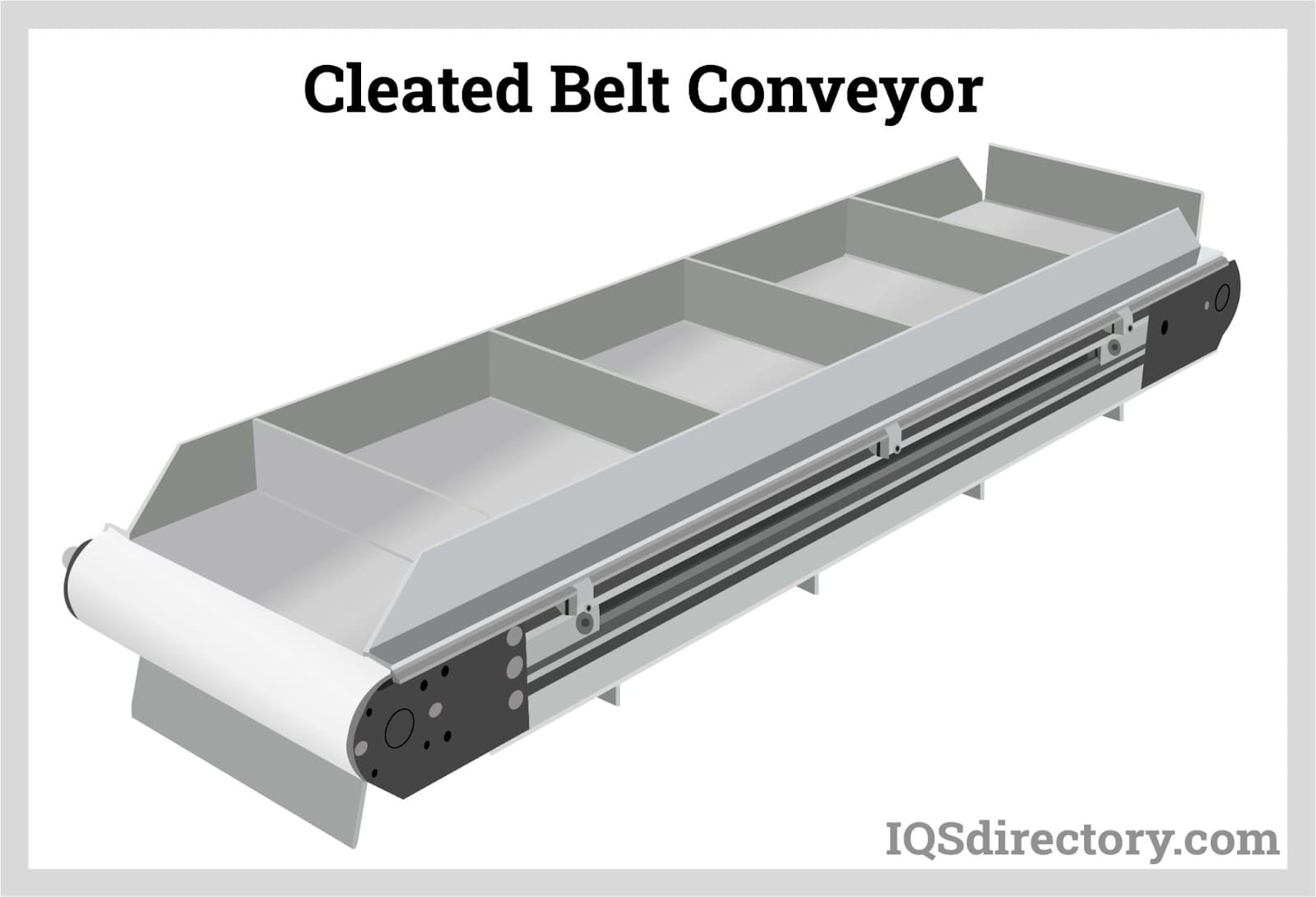
The cleats come in different shapes and sizes which include:
Inverted Capital T
This cleat will be standing at 90 degrees to the belt to give support and flexibility to delicate items. It is most suited to do light jobs and handling small parts, packaged goods, and food products.
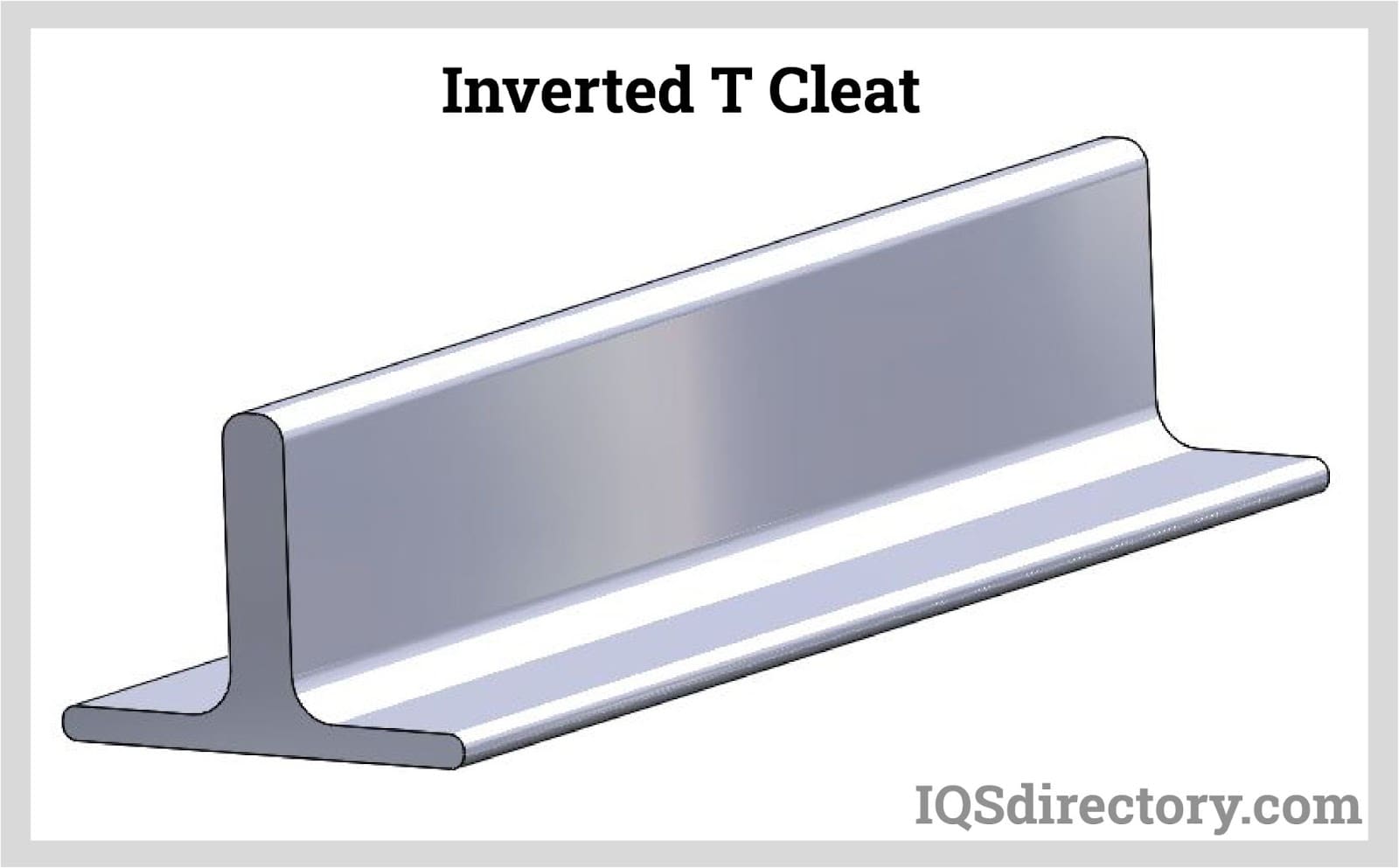
Forward- Leaning Capital L
Because of its orientation, it can easily resist leverage forces. It can be used to scoop granules and hold them against gravity. It can be employed to hold a light to medium-weight granules.
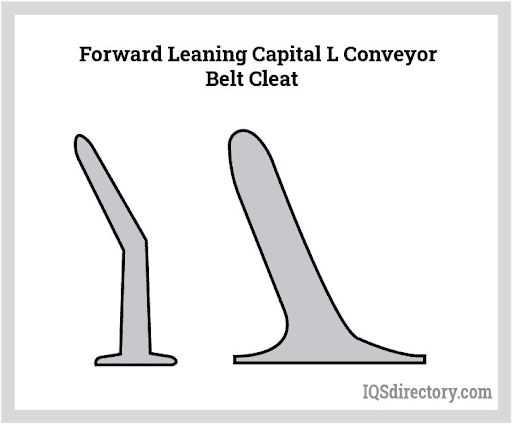
Inverted V Cleats
These cleats are less than 5cm in height to have the same effect that a trough has. They can be used to transport heavy or big bulks of material because of their relatively short cleat, which can withstand high impacts.
Lugs and Pegs
These cleats are used to aid the runoff of liquids after washing off items like vegetables and fruits. Lugs and pegs are a cost-effective way to convey substances and items that do not need to be supported all along the length of the belt such as large cartons or rods. They can also be used to selectively move products that exceed a wanted size and even hold single products in place.
Other uses of Cleated Belt Conveyors include:
- Escalators are a modification of cleated belt conveyors in the sense they carry loose materials up an incline that is steep.
Curved Belt Conveyor
This conveyor uses a frame that is fabricated and already curved so as to carry items around tight corners. It is used where space is limited and winding conveyors would save space. The curves can go as steep as 180 degrees.
Modular plastics with interlocking segments are used but only if the conveyor has a straight run before it curves. Flat flexible belts will be used if the belt is primarily only curved.
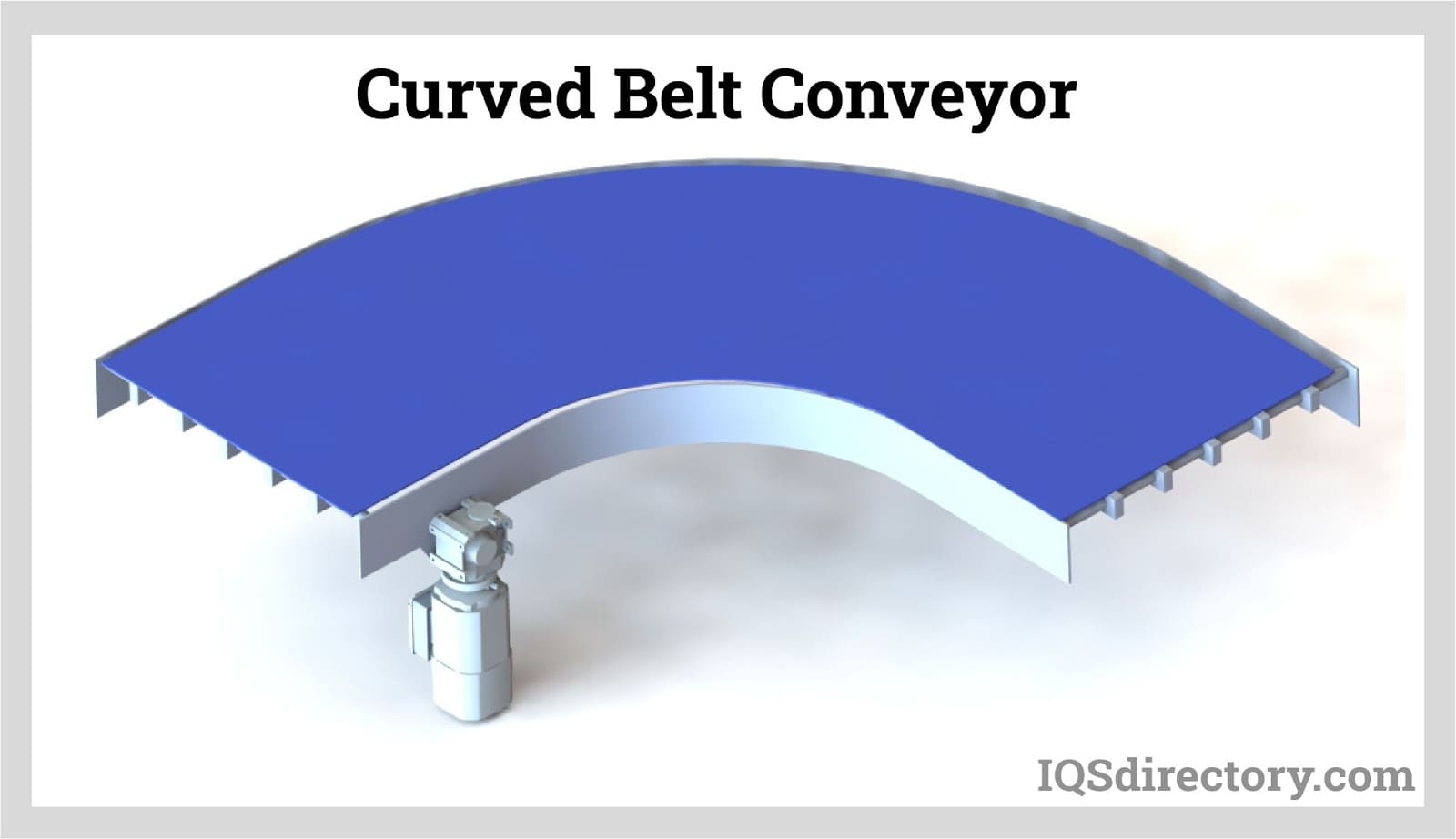
Incline/Decline Belt Conveyor
Incline conveyors require tighter tension force, higher torque, and traction on the belt surface to prevent items from falling off the belt conveyor. Thus, they will incorporate a gear motor, a center drive, and a take-up. The belt must also have a rough surface to allow for greater traction.
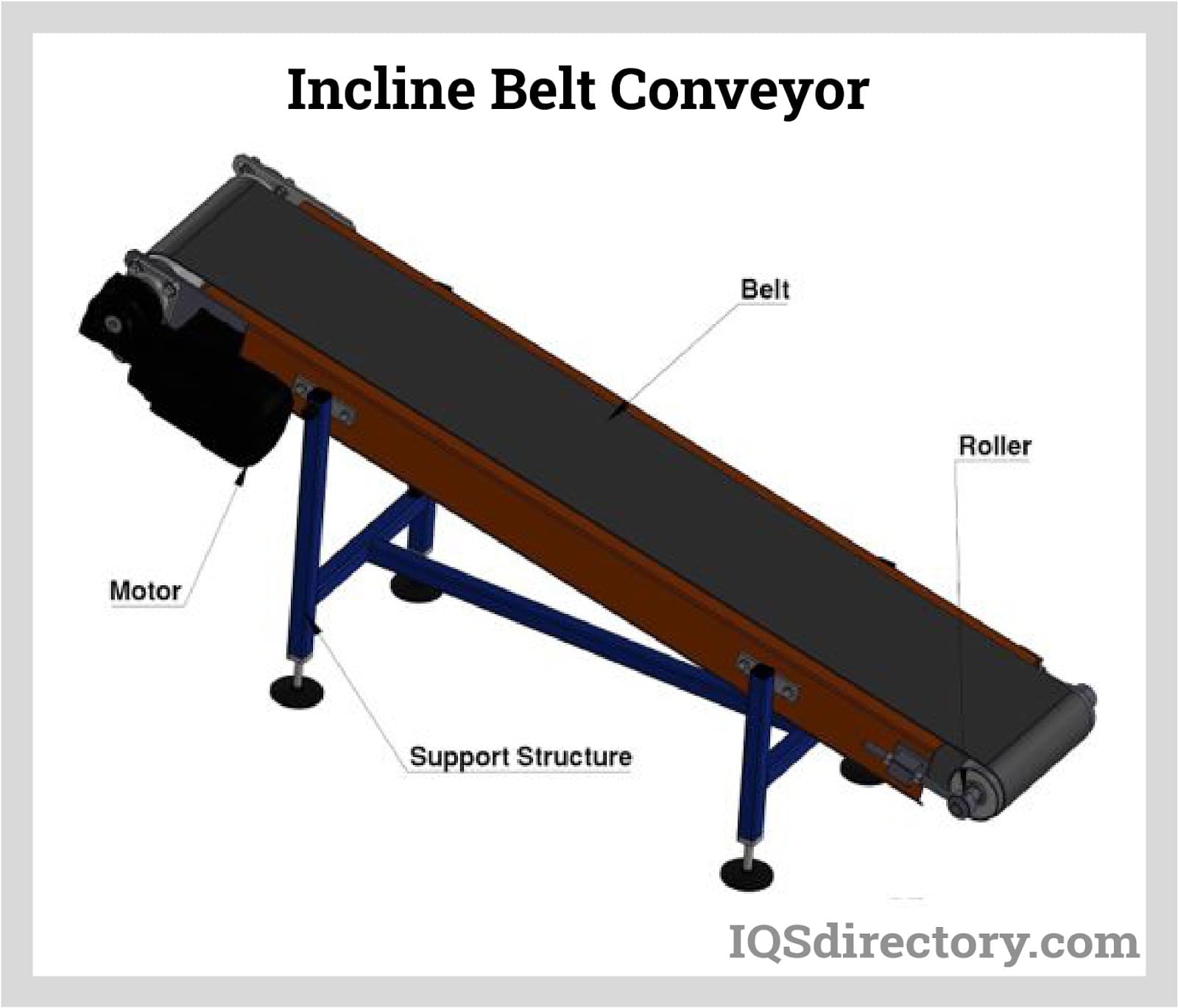
Just like cleat conveyors, these also carry items up a gradient not letting the items fall off. They can also be used to boost the gravitational flow of fluids.
Sanitary Washdown Conveyor
In the pharmaceutical and food industries, sterilization and harsh washing usually need to happen, in line with health and safety guidelines. Washdown and sanitary conveyors are designed to handle sanitary procedures of that nature. The belts employed here are usually flat belts that are relatively thin.
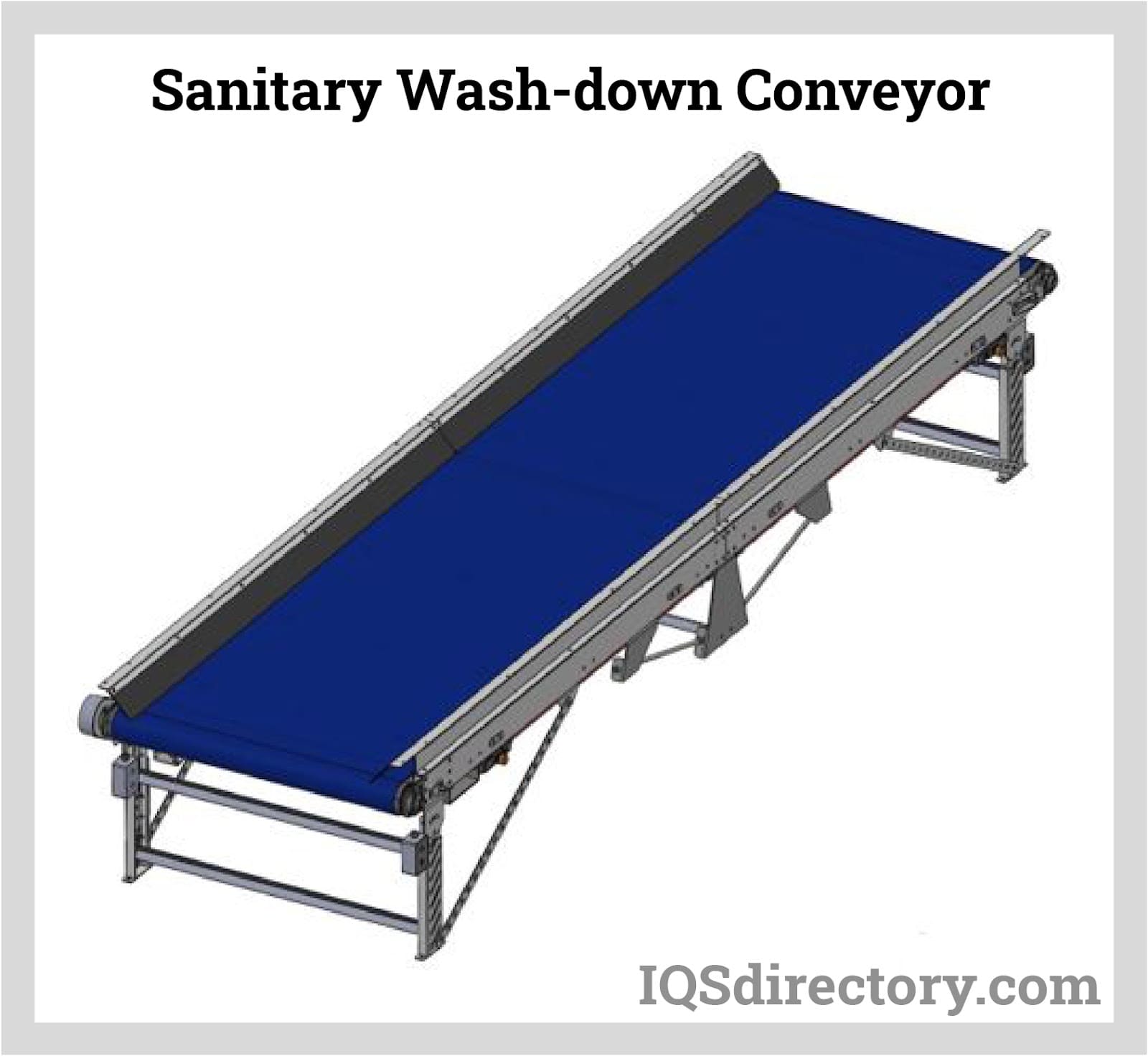
Sanitary wash-down belt conveyors are used in items coming from extreme temperatures like freezers and furnaces. Sometimes they have to work in hot oil or glaze. Because of how well they can handle greasy environments, they are sometimes used to offload oil drums and crates from ships.
Troughed Conveyors
A troughing belt conveyor is not a distinct type of belt because troughing can be incorporated in any conveyor type.
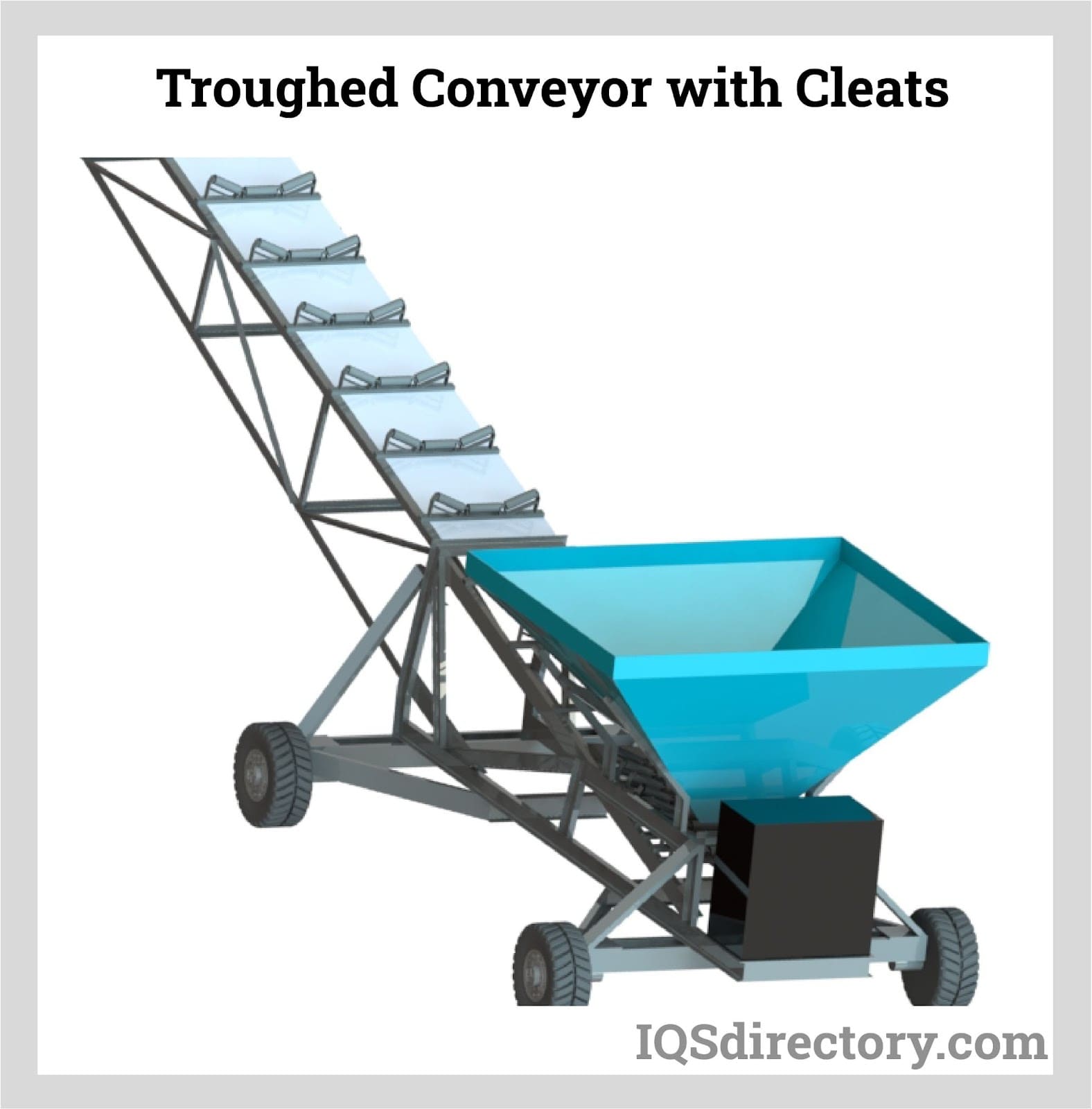
It utilizes a belt that forms a troughed shape because of the troughing idler rollers under it.
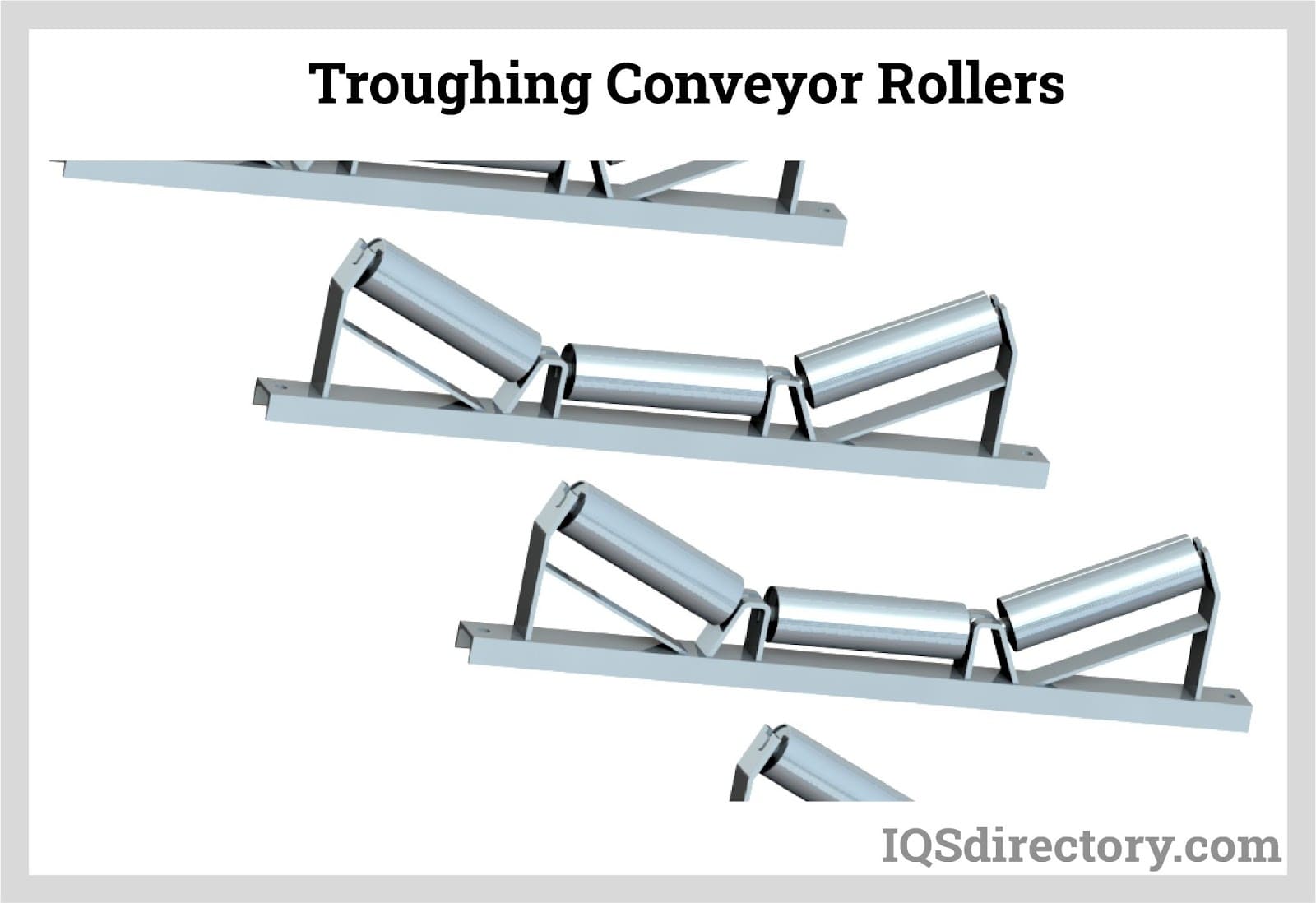
The troughing idler rollers have a central roller that has a horizontal axis of rotation, and the outer two rollers (wing rollers) have an axis lifted at an angle to the horizontal. The angle is usually around 25 degrees. Troughing only happens to the top idler rollers and never really at the bottom.
Higher angles of troughing will cause permanent damage to the belt. If the belt is troughed at steeper angles, it will retain its cup shape and will become difficult to clean, difficult to track as well as break the carcass of the belt. It also might reduce the amount of surface contact with the idler rollers, which ultimately reduces the efficiency of the belt conveyor system.
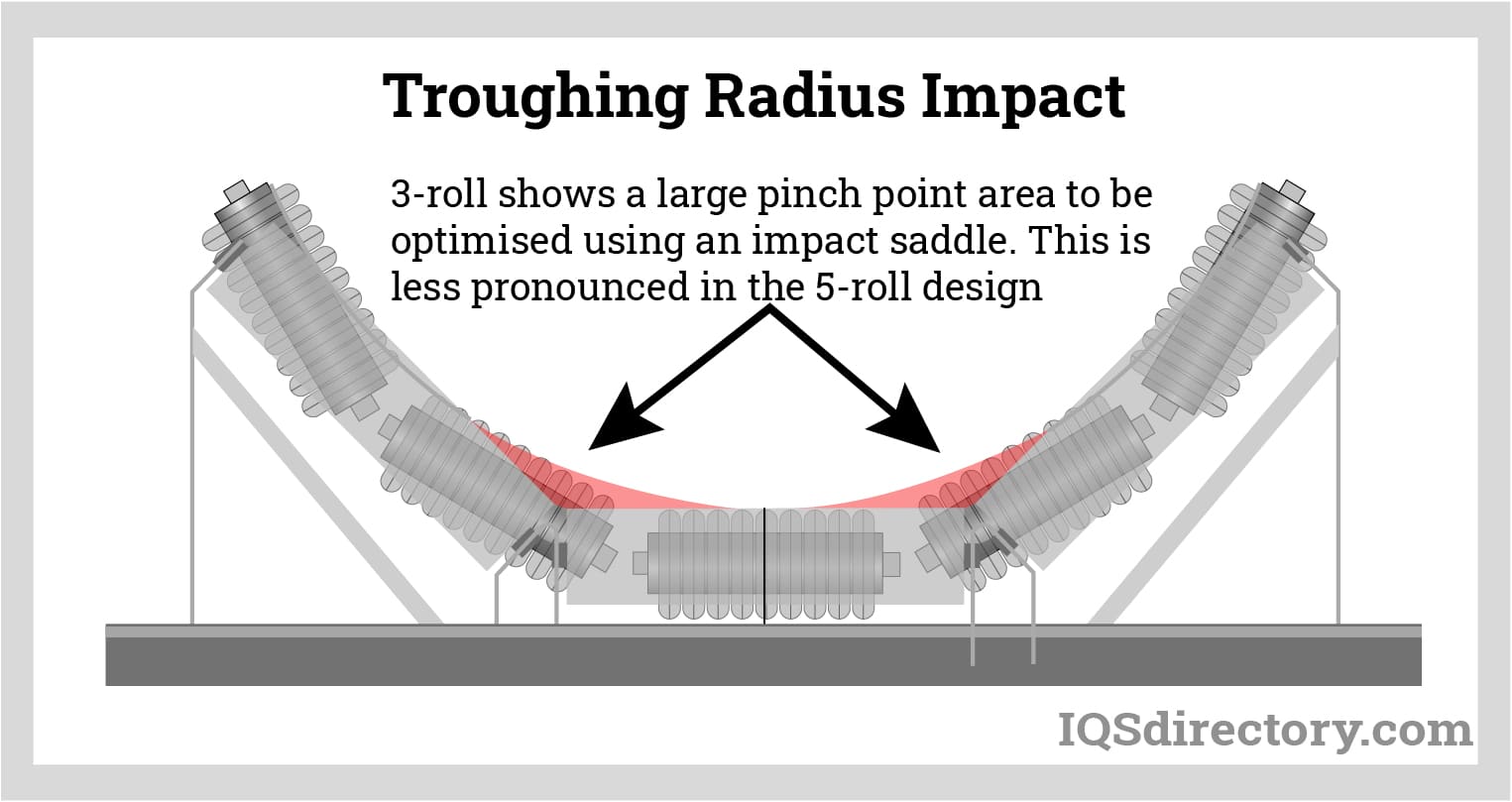
Trough belts usually operate in one plane, which is either horizontal or inclines, but inclines that are only until 25 degrees. The belt must have a radius big enough so that it can still touch all the rollers in the troughing idler. A sharper angle of troughing means the belt will not touch the center idler roller, thereby undermining the structural integrity of the belt as well as the efficiency of the conveyor system at large.
Chapter 3: Design and Selection of Belt Conveyors
When designing a conveyor belt, the major parameters to be considered are:
- Motor and gearbox selection
- Speed of belt
- Tension and take-up
- Material to be conveyed
- The distance over which to be transported
- Working environment e.g. temperature, humidity, etc.
Motor and Gearbox Selection
To aid the selection of the motor, one must first know what the effective pulling force required for the conveyor is.
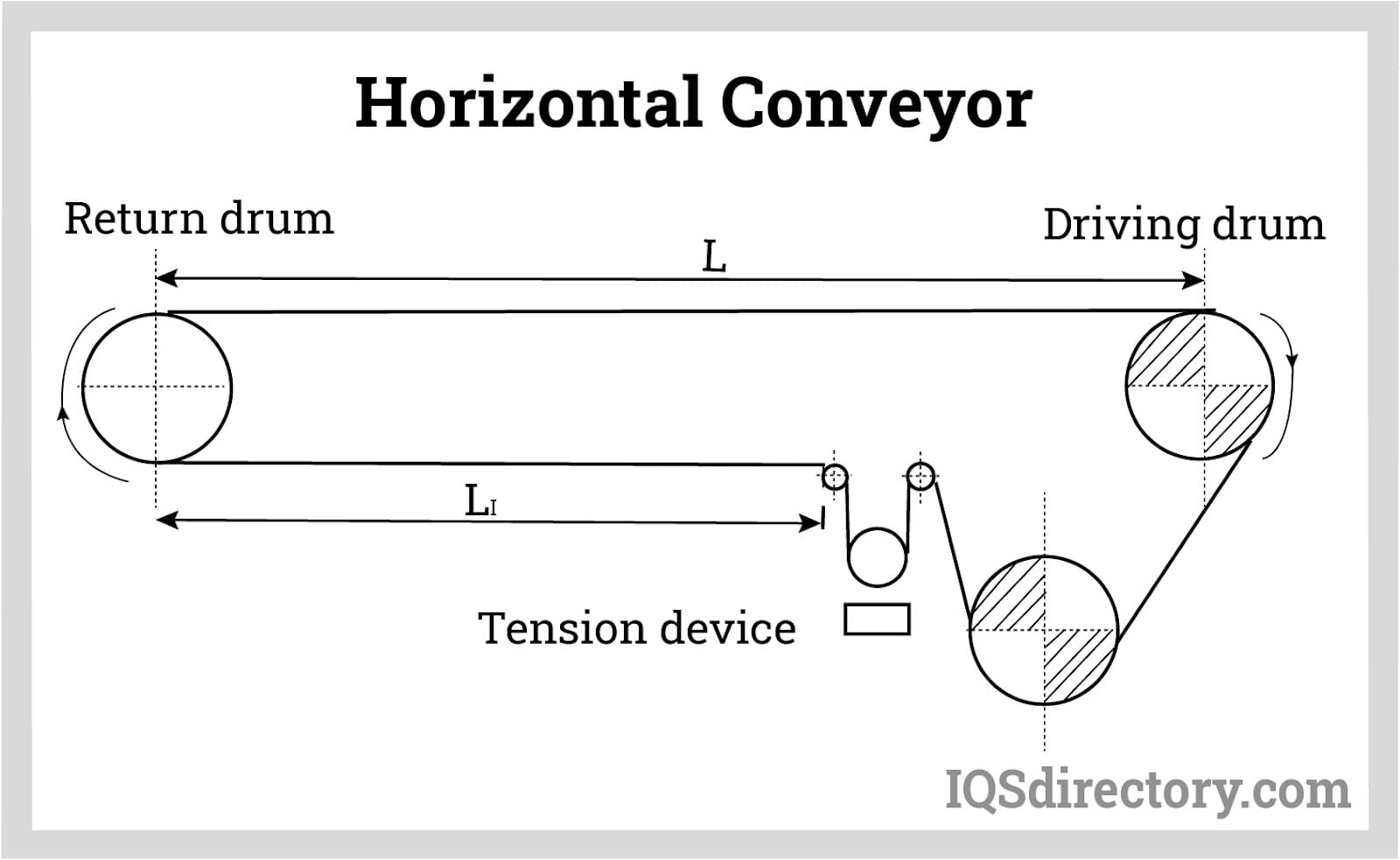
For a simple horizontal conveyor, the effective pulling force is given by the formula below:
Fu=µR*g*(m+mb+mR)
Where
- Fu = Effective pulling force
- µR = Friction Coefficient when running over roller
- g = Acceleration due to gravity
- m = Mass of goods conveyed on the whole length of the conveyor
- mb = Mass of Belt
- mR = Mass of all rotating rollers minus mass of drive roller
For a system on an incline, the effective Pulling force is given as below:
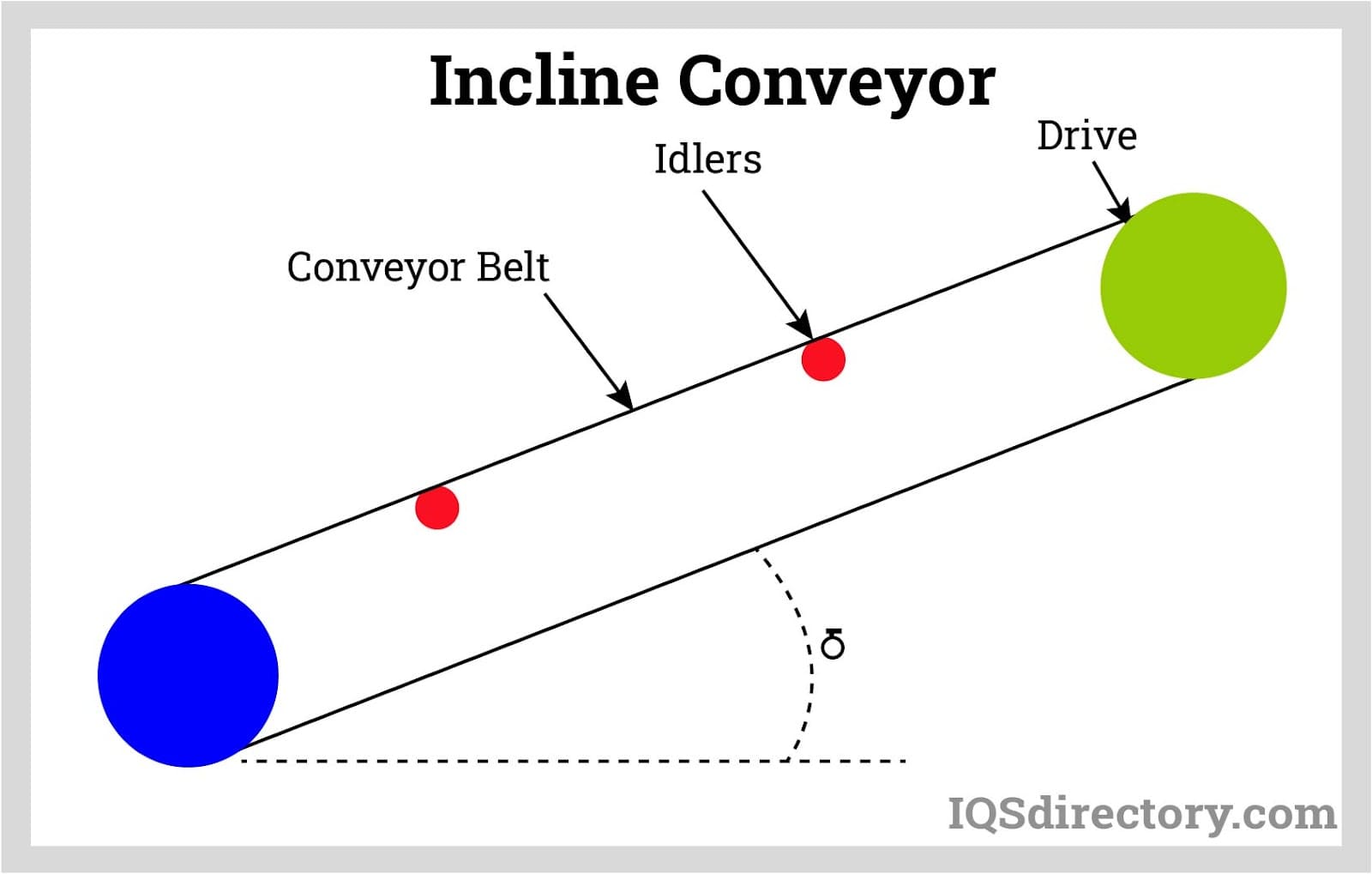
Fu=µR*g*(m+mb+mR)+g.m.sina
Where
- Fu = Effective Pulling Force
- µR = Friction Coefficient when running over roller
- g = acceleration due to gravity
- m = mass of goods conveyed on the whole length of the conveyor
- mb = Mass of Belt
- mR = Mass of all rotating rollers minus mass of drive roller
- α = Angle of inclination
Once the pulling force is determined, it becomes easy to come up with the torque and hence the motor to use and the gearbox will follow after.
Speed of Conveyor
The speed of the conveyor will be the circumference of the drive pulley multiplied by the revolutions per unit time.
Vc=D.F
- Vc = Speed of conveyor belt in ms-1
- D = Diameter of drive pulley in meters.
- F = Revolutions of drive pulley per second
Tension and Take-up of the Belt
Take-up is an important component in maintaining and achieving optimum belt tension. This will contribute greatly to the process and its mechanical stability.
A properly tensioned belt will wear evenly and will contain material evenly in the trough and run centrally when going over the idlers.
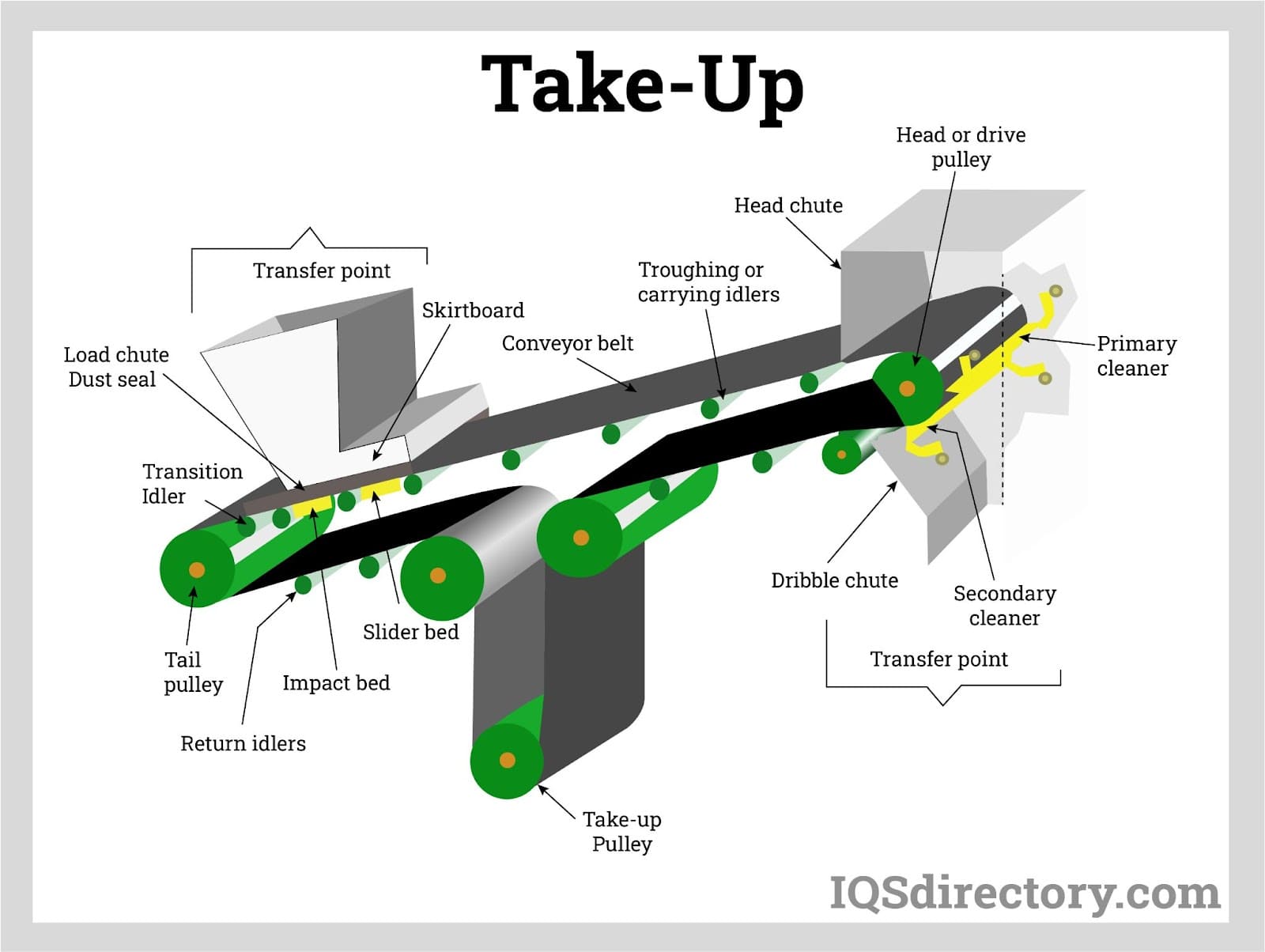
All conveyors will always experience some stretch in their length and width. Generally, it is acceptable that a new belt will stretch with an additional 2 percent of its original length. Since this fraction will add to the length of the belt, the entire belt will have a slack. This slack will have to be taken up in order to retain optimum tension.
The longer a conveyor is, the bigger the stretch will be. Using the 2 percent stretch, a 2-meter long conveyor can stretch 40mm, but a 200-meter long conveyor will slack 4 meters.
Take-up is also profitable when the belt has to undergo maintenance. In such a case the take-up is simply let loose and the personnel will undertake maintenance with ease.
Types of Belt Conveyor Take-Ups
There are many configurations of take-ups, each having its own pros and cons. The common configurations of belt conveyor take-up are the gravity take-up, screw take-up, and horizontal take-up.
Screw Take-Up
The screw take-up configuration uses mechanical force to take up all the slack in the belt. It achieves it by adjusting a threaded rod that is attached to one of the rollers, especially the tail roller. This threaded rod will be on each side of the roller so it can also work as an alignment procedure. Since this is a hands-on manual approach, screw take-up is often called manual take-up.
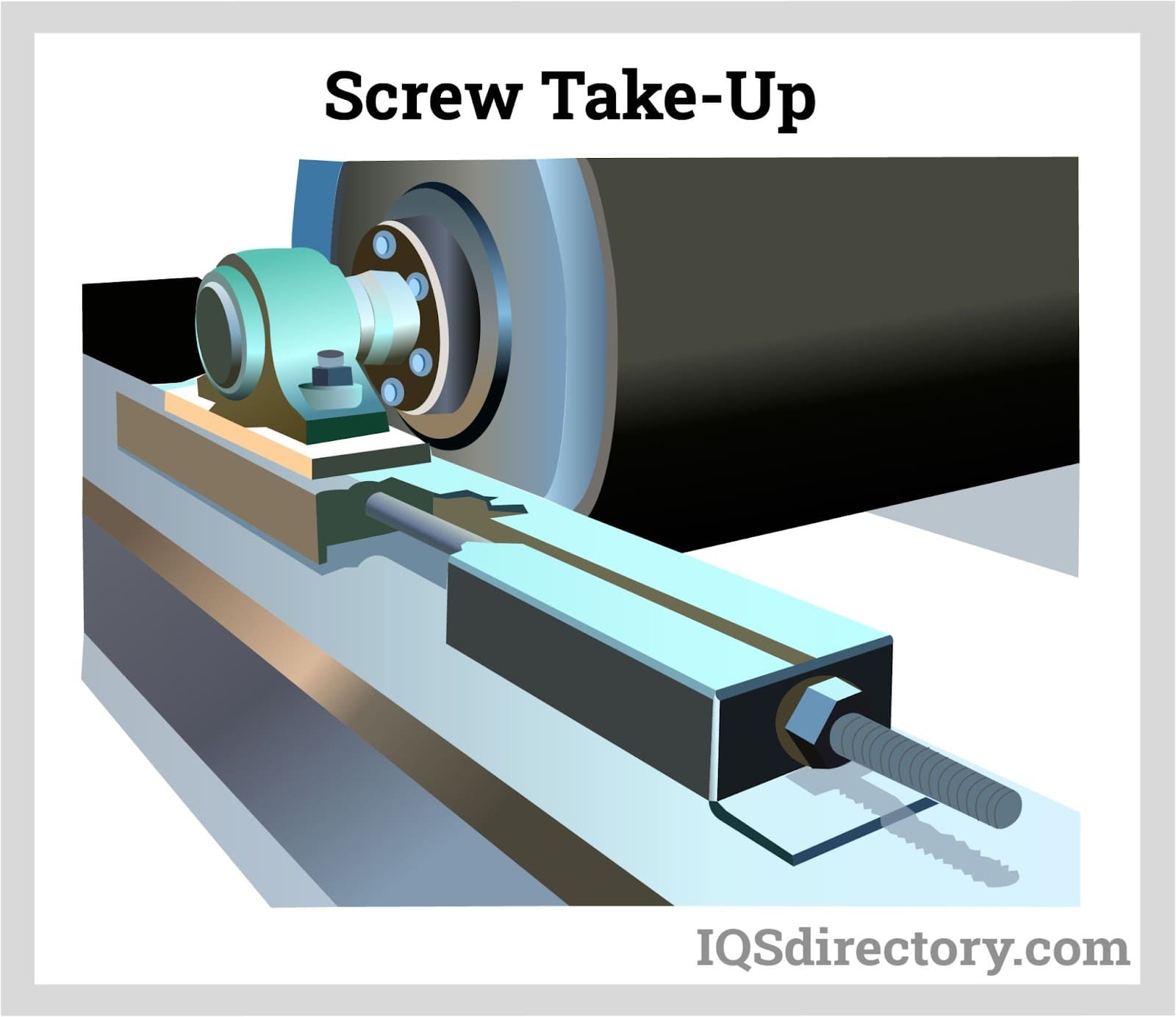
Another style is called the top angle take-up. Though it is also popular, it needs a large and heavy tail frame to archive. The guards also have to be large.
Screw take-ups are a cheap and effective way of controlling belt tension for relatively short conveyors and are the easiest and standard take-up choice for many.
Gravity Take-Up
Screw take-ups are usually not suited to lodge the length of the stretch that happens in conveyors longer than 100 meters. In these setups, gravity take-up will be the best approach to belt tensioning.
A gravity take-up assembly uses three rollers where two will be bend rollers and the other one will be a gravity or sliding roller that routinely manages the belt tension. A counterweight that will be mounted to the gravity take-up roller pulls down on the belt to preserve tension through gravity. The bend rollers direct the belt slack around the gravity take-up roller.
The full take-up assembly is integrated into the bottom of the conveyor frame and makes a continuous tension on the belt. This way of self-tensioning arrangement allows the take-up to easily adjust to sudden spikes in tension or load.
So, the gravity take-up method always maintains the appropriate belt tension and avoids damage to the belt because of sudden load or tension spikes. Since gravity tensioners are self-tensioning, they need less maintenance, unlike the screw take-up method.
Their maintenance is normally needed when the belt has reached the end of its lifespan. That is when it has stretched such that the assembly will have reached the bottom of the set travel distance. When this happens, the conveyor belt will either need replacement or be cut and vulcanized. A gravity take-up system is also known as an automatic take-up because it adjusts automatically.
Horizontal Take-Up
The horizontal take-up is a substitute for gravity take-up but only when space is limited. This take-up is similar to gravity take-up, but instead of the assembly being located below the belt, it is situated vertically behind the tail roller. This makes it especially beneficial when the conveyor is located on a grade that does not have any additional space under the conveyor.
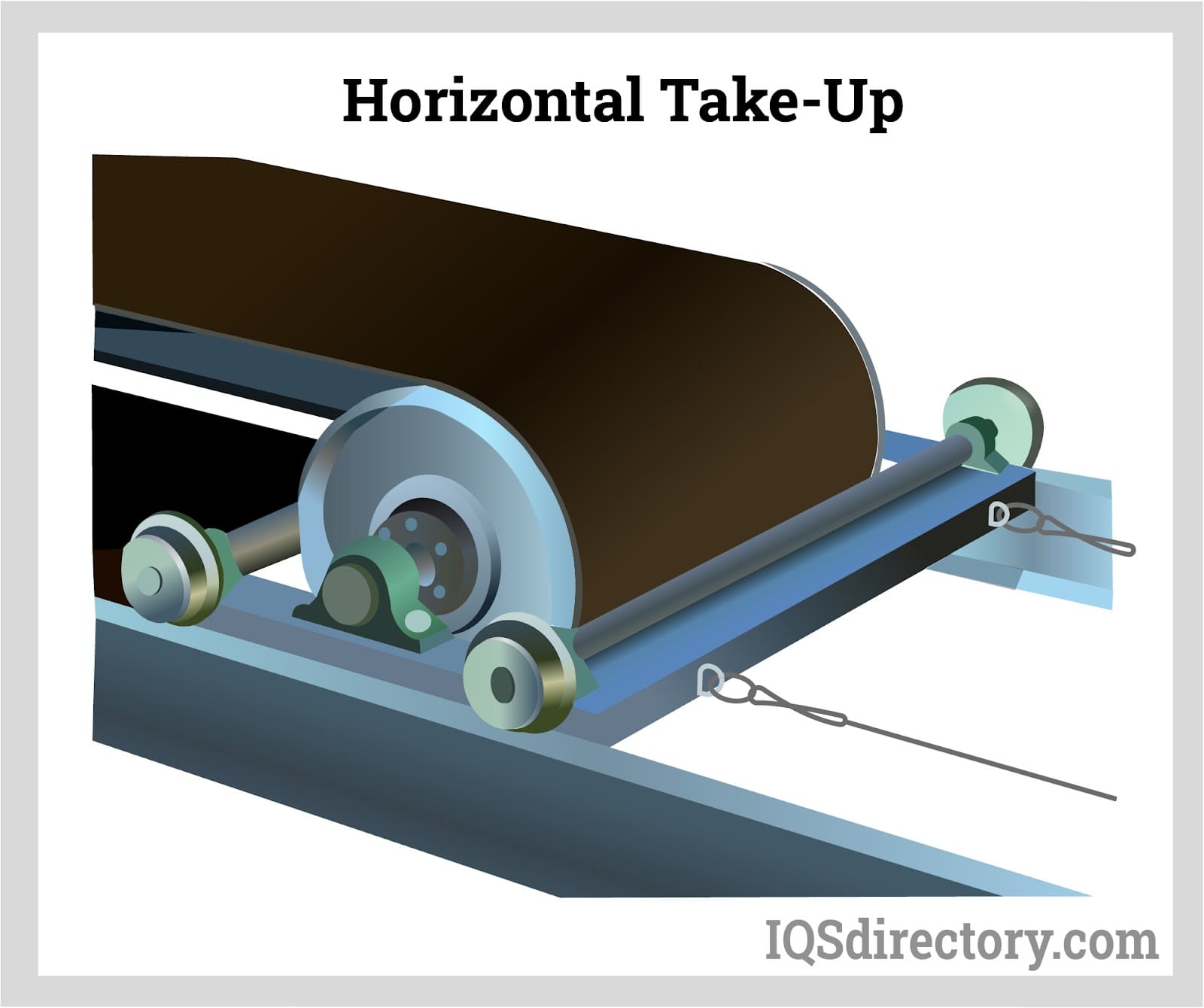
Because the horizontal take-up will not fall below the conveyor, an arrangement of cables and pulleys is used for tensioning the belt with a weight box. The cables attached to the tail pulley ride on a carriage which then allows it to be moved in and out of place.
Chapter 4: Applications and Benefits of Belt Conveyors
This chapter will discuss the applications and benefits of belt conveyors. It will also discuss common belt conveyor problems, their causes, and the environmental effects on belt conveyors.
Applications of Belt Conveyors
Conveyor belts have a wide range of applications across industries. These include:
Mining Industry
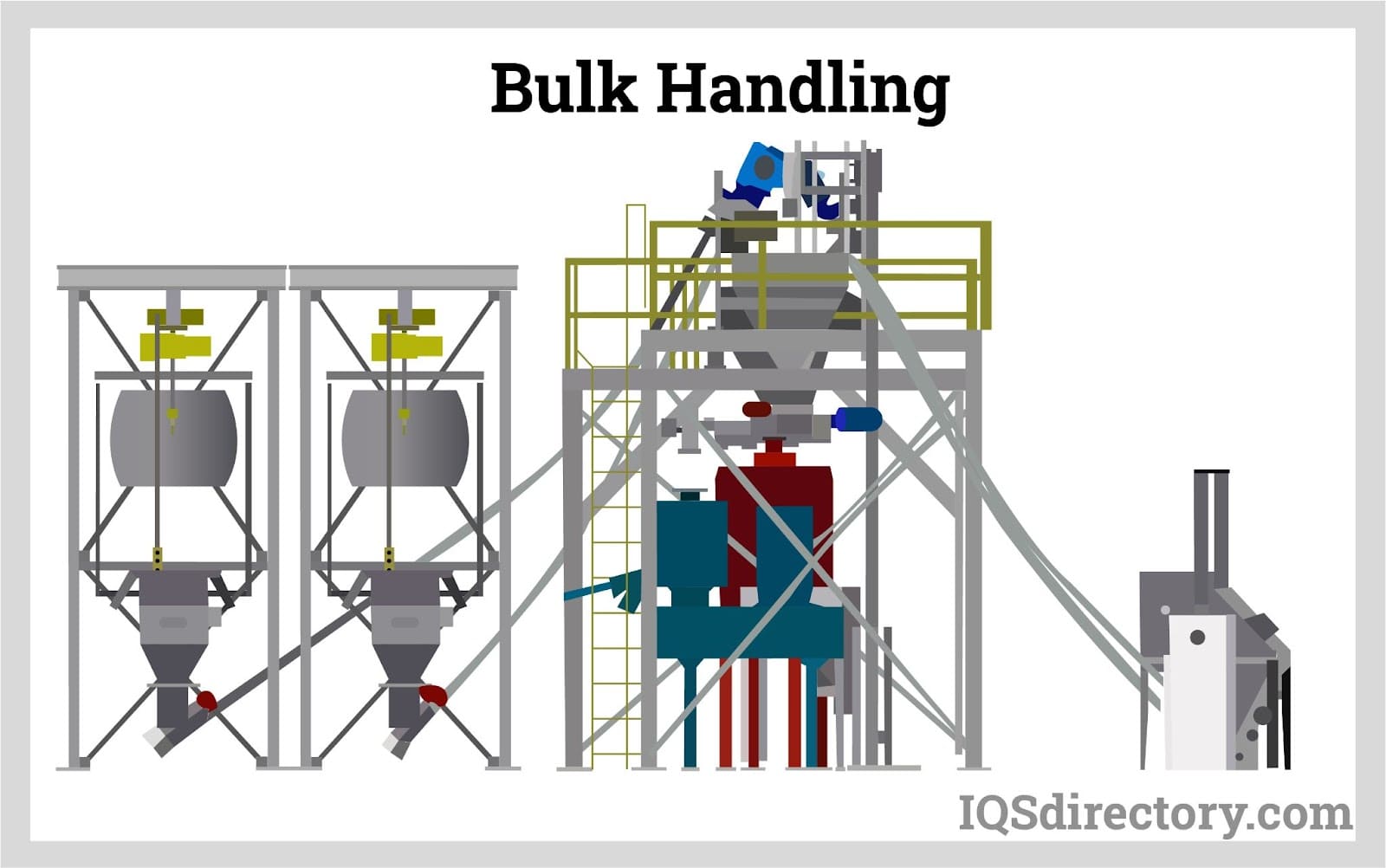
- Bulk handling
- Processing plants
- Taking ores from the shaft to the ground level
Automotive Industry
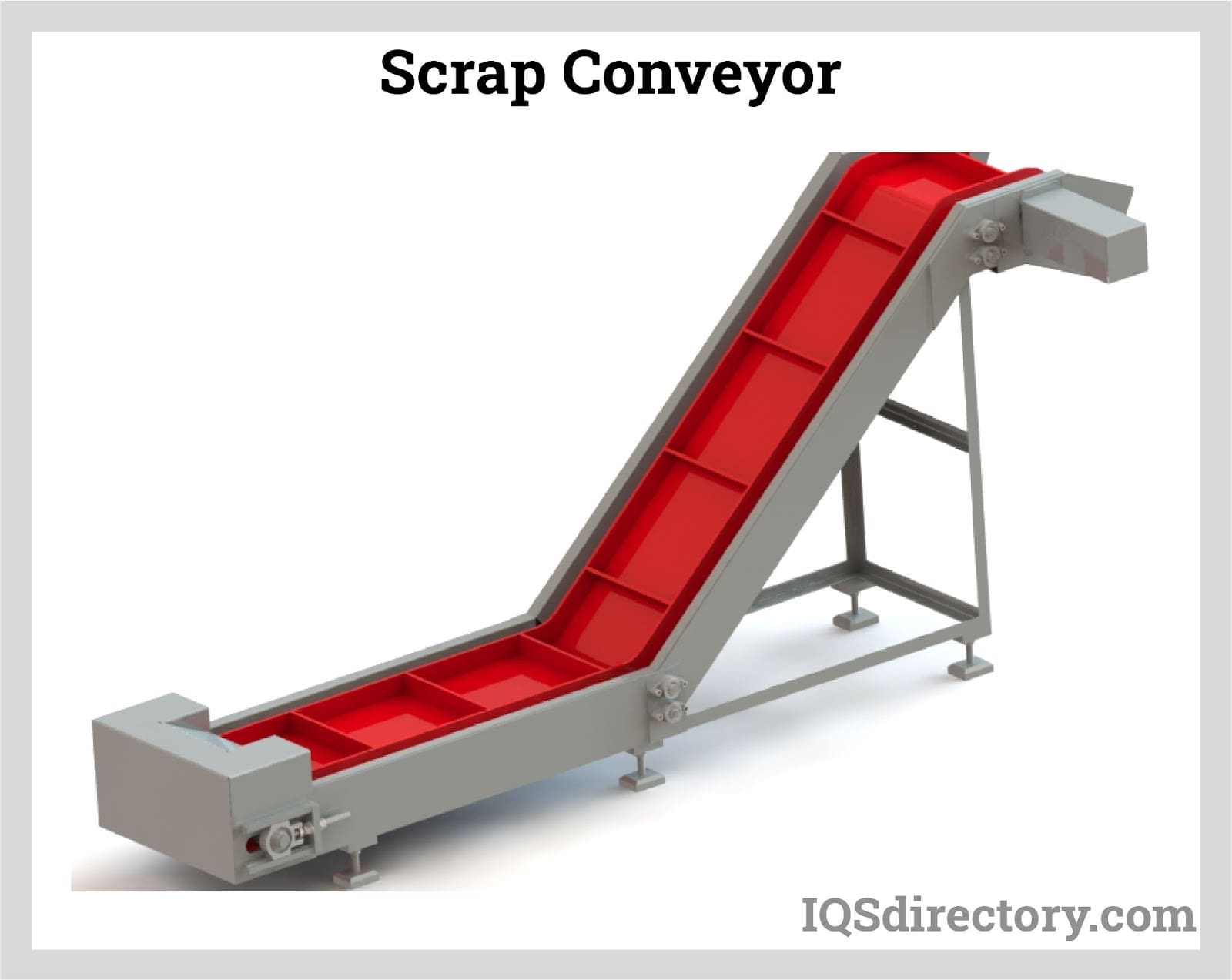
- Assembly line conveyors
- CNC machines’ scrap conveyors
Transport and Courier Industry
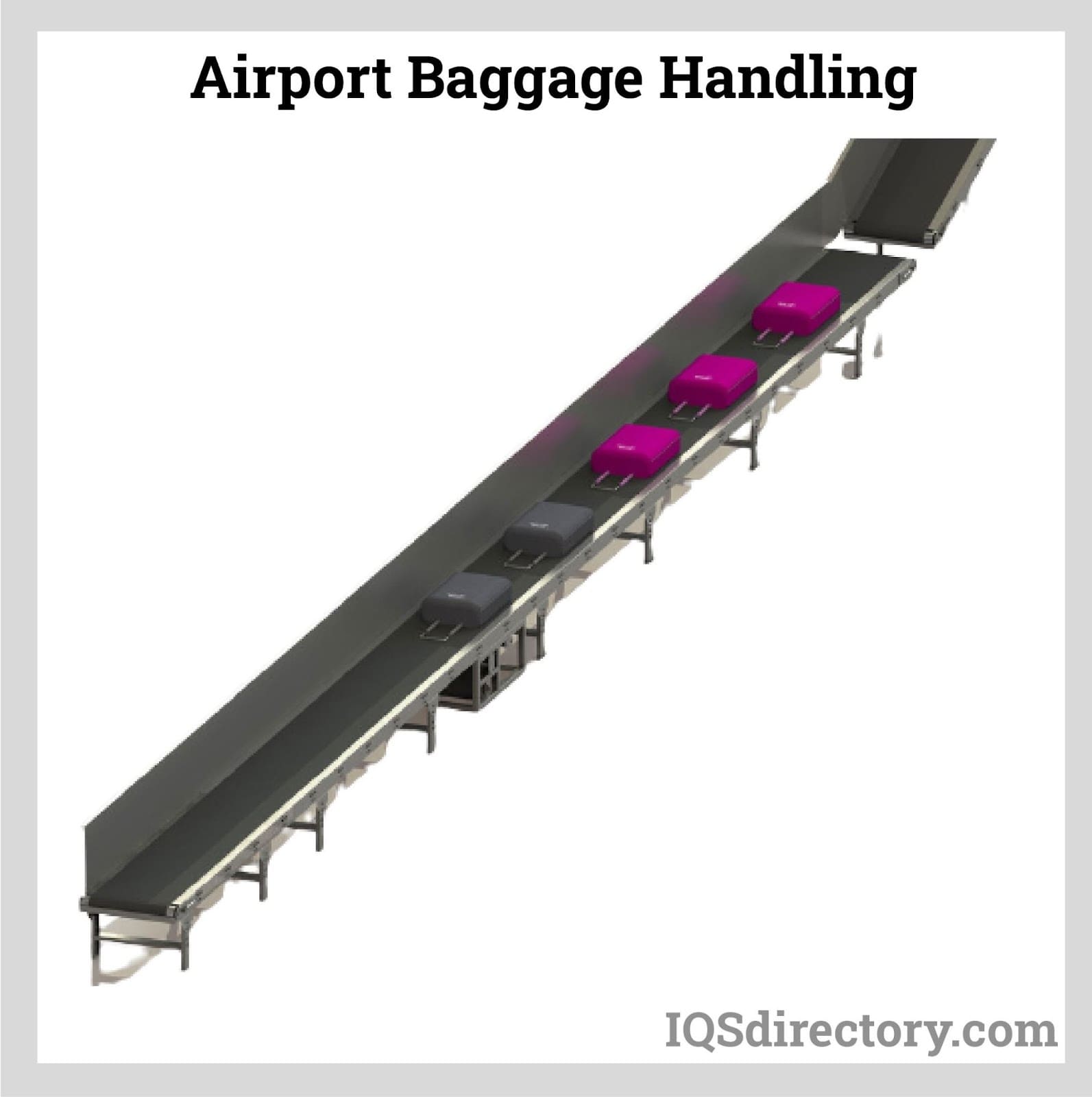
- Baggage handling conveyors at airports
- Packaging conveyors at courier dispatch
Retailing Industry
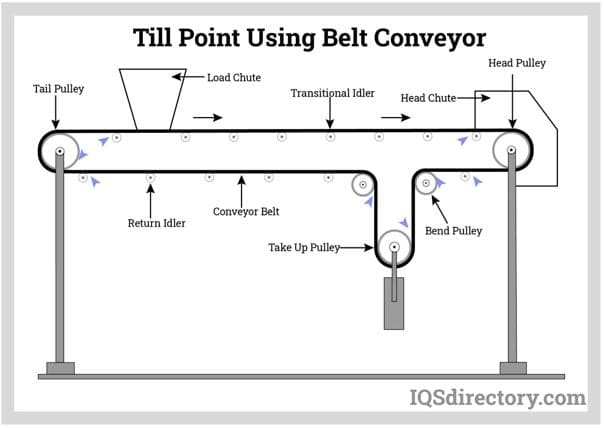
- Warehouse packaging
- Till point conveyors
Other conveyor applications are:
- Food handling industries for grading and packaging
- Power generation conveying coal to the boilers
- Civil and construction as escalators
Advantages of Belt Conveyors
The advantages of belt conveyors include:
- It is a cheap way of moving materials over long distances
- It doesn’t degrade the product being conveyed
- Loading can be done at any place along the belt.
- With trippers, the belts can offload at any point in the line.
- They do not produce as much noise as their alternatives.
- Products can be weighed at any point in the conveyor
- They can have long operating times and can even work for months without stopping
- Can be designed to be mobile as well as stationary.
- Have less dangerous hazards to human injury
- Low Maintenance costs
Common Belt Conveyor Problems
There are several problems that belt conveyor systems can be prone to and would need to be mitigated. These include:
Problem 1: The Conveyor Runs to One Side at a Certain Point in the System
The causes of this would include:
- Material building upon the idlers or something causing the idlers to stick
- Idlers no longer run square to the path of the conveyor.
- Conveyor frame tilted, crocked, or no longer level.
- Belt was not spliced squarely.
- The belt is not loaded equally, probably loaded off-center.
Problem 2: The Conveyor Belt Slips
The causes of this would include:
- Traction is poor between belt and pulley
- Idlers stuck or not rotating freely
- Worn out pulley legging (the shell around the pulley that helps increase friction).
Problem 3: Overstretching of the Belt
The causes of this would include:
- Belt tensioner is too tight
- Belt material selection not done properly, probably “under belted”
- Conveyor counterweight is too heavy
- The gap between idler rolls is too long
Problem 4: The Belt Wears Excessively at the Edges
The causes of this would include:
- The belt is loaded off-center
- The high impact of material on the belt
- Belt running against conveyor structure
- Material Spillage
- Material is trapped between belt and pulley
Environmental Effects On Belt Conveyors
Water, petroleum products, chemicals, heat, sunlight, and cold all influence the belt conveyor’s performance and life.
The causes and the effects can be categorized as:
Moisture Effects
- Belt rots and cracks
- Belt loose adhesion
- Causes slippage
- Steel carcasses can rust
Effects of Sunlight and Heat
- Rubber will dry out and weaken
- Rubber will crack
- Rubber may have more slack and thus reduce belt tension
Cold Effects
- The belt stiffens and becomes harder to guide and train
- On incline systems, frost can build up and cause slippage
- Ice can build up in chutes and clog them
Effects of Oil
- Rubber will swell
- Rubber will lose tensile strength
- Rubber will lose tensile strength
- The belt will wear quicker
- Rubber will lose adhesions
Conclusion
A belt conveyor is a system designed to transport or move physical items like materials, goods, and even people from one point to another. Unlike other conveying means that employ chains, spirals, hydraulics, etc., belt conveyors will move the items using a belt. It is critical to be cognizant of the design considerations and applications of various belt conveyors depending on the intended use.
The implementation of video
Conveyor industry resources for engineers



Structural Design and Criterion of Roller Conveyor
The roller conveyor is suitable for conveying all kinds of boxes, bags, pallets, etc. Bulk materials, small items, or irregular items need to be transported on pallets or in turnover boxes.
Pipe belt conveyor and application scenarios
The pipe conveyor has a wide range of applications. It can transport materials vertically, horizontally, and obliquely in all directions. And the lifting height is high, the conveying length is long, the energy consumption is low, and the space is small.
GCS belt conveyor types and application principle
Common belt conveyor structure in various forms, climbing belt machine, tilt belt machine, slotted belt machine, flat belt machine, turning belt machine and other forms.
WANT TO WORK WITH US?
Relating Reading
Post time: May-26-2022
